June 11: Ephesus
What is Ephesus? It's the site of a large city and cultural complex built by Romans in the first century BC. At one time, 250,000 people lived in Ephesus. Compared to Troy, Pergamum, and the Asclepieum, Ephesus is huge - both in area and the massiveness of the ruins. It is also quite popular with tourists, and more so at the time we visited because many of the cruise ships opted to visit Ephesus instead of Istanbul because of the Taksim Square protests. (Good online references: Ephesus, Wikipedia, and Bible Places.)
The ancient city is south of our hotel in Izmir, on the western coast of Turkey, near the town of Selcuk. We left our hotel early so as to arrive when it opened at 10 am - Ali knew it was best to see Ephesus as early as possible, before it got hot. (It was still hot.)
Like all of Turkey, Ephesus was conquered and lost by different ruling groups over the centuries; the following paragraph is my own abbreviated timeline.
Ephesus was founded by Ionian Greeks in the 10th century BC. Later it was controlled sequentially by the Cimmerians, various tyrants, the Lydians, the Persians, the Ionians (again), and in the 5th century BC, the Persians (again). Then, in 334 BC, Alexander the Great liberated Ephesus. By the 1st century BC, Ephesus was under firm Roman control. After Augustus became emperor in 27 BC, Ephesus entered a period of prosperity and grew to a population of 250,000, making it one of the largest cities in the Mediterranean area. The city was damaged by the Goths in 263 AD. Constantine I, who reigned from 306-337 AD, rebuilt the city. From 395-1308 AD, Ephesus was part of the Byzantine Empire (Greek-speaking Roman Empire). The Turks of the Ottoman Empire controlled the city from the fourteenth century until the establishment of modern Turkey in the twentieth century.
We enter the site in a bustle of tourists and pass water closets and souvenir stands. John and I bought Turkey hats to protect our heads. Then we follow the path into Ephesus. Another tour group gathers under a shady tree; all we see at first are more stone-sized ruins. Not too impressive.
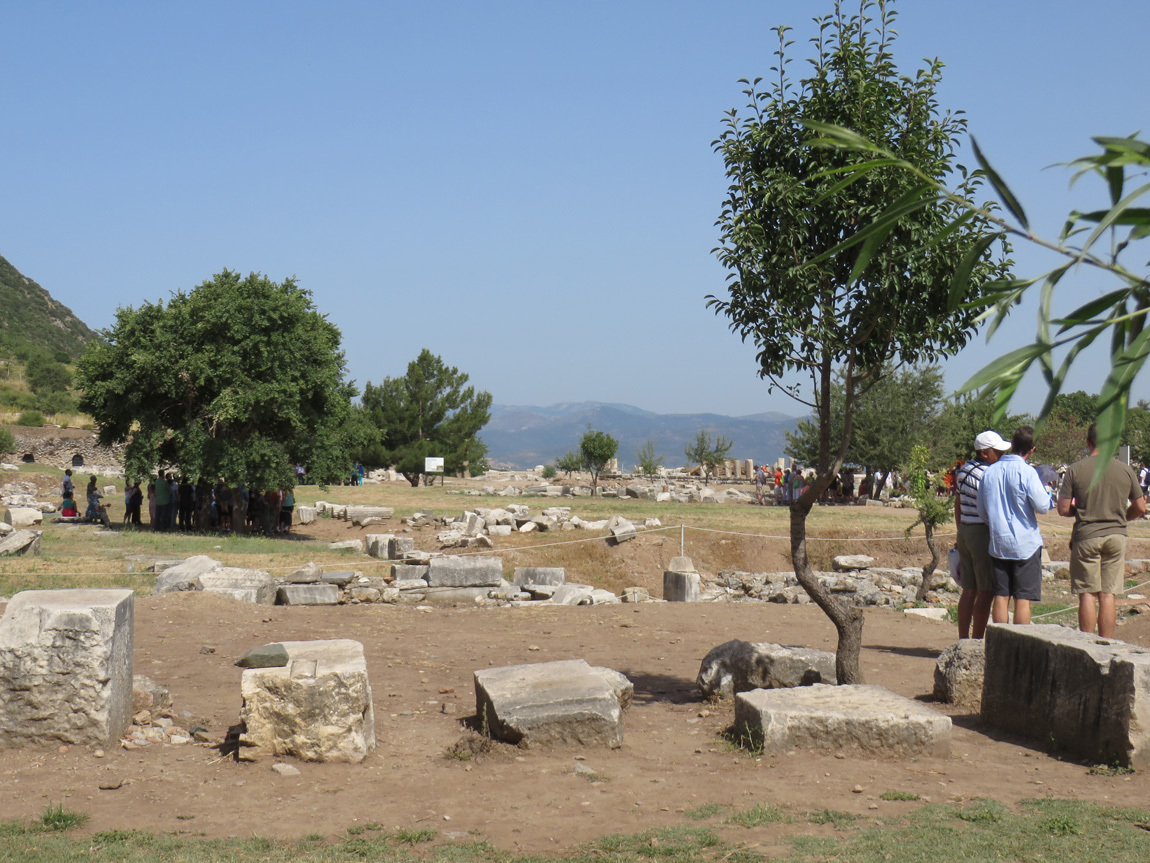
Then we do come to an impressive structure: the Bath of Varius, dating from the second century.
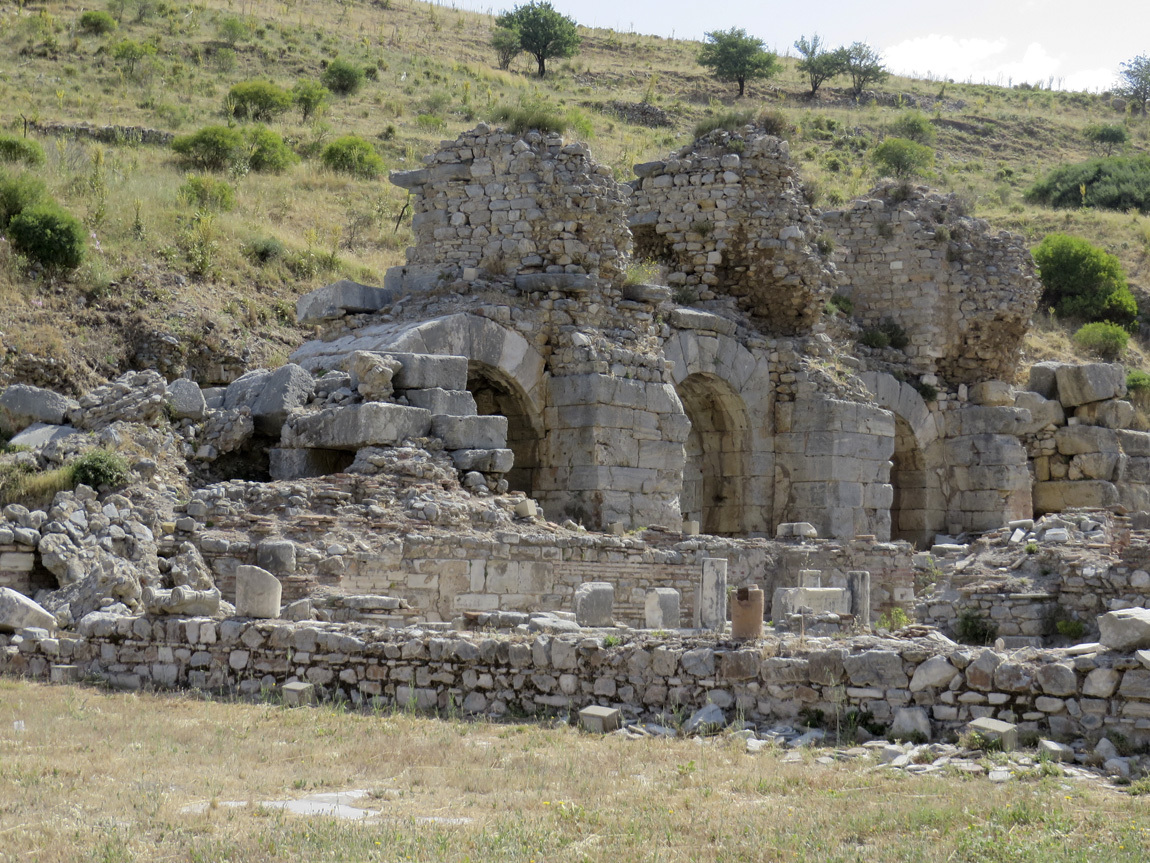
A pile of pipes used to carry hot air to heat the buildings:
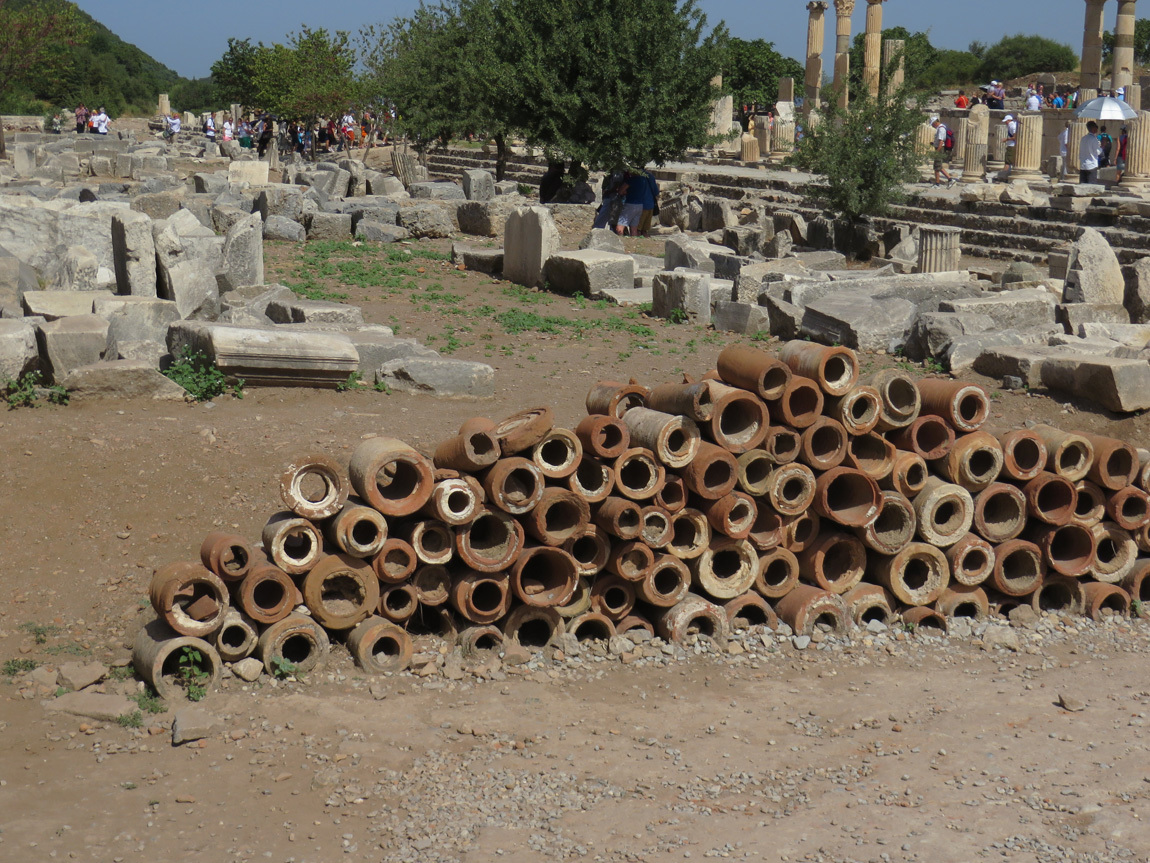
Next to the Bath of Varius is the Basilica. It was used for commercial business and courts of law. Statues of Augustus and his wife used to be in the Basilica, but they are now in the Ephesus Museum (in Selcuk, Turkey). The Basilica was destroyed in an earthquake in the fourth century. I liked the figures of the bulls on top of the big stones.
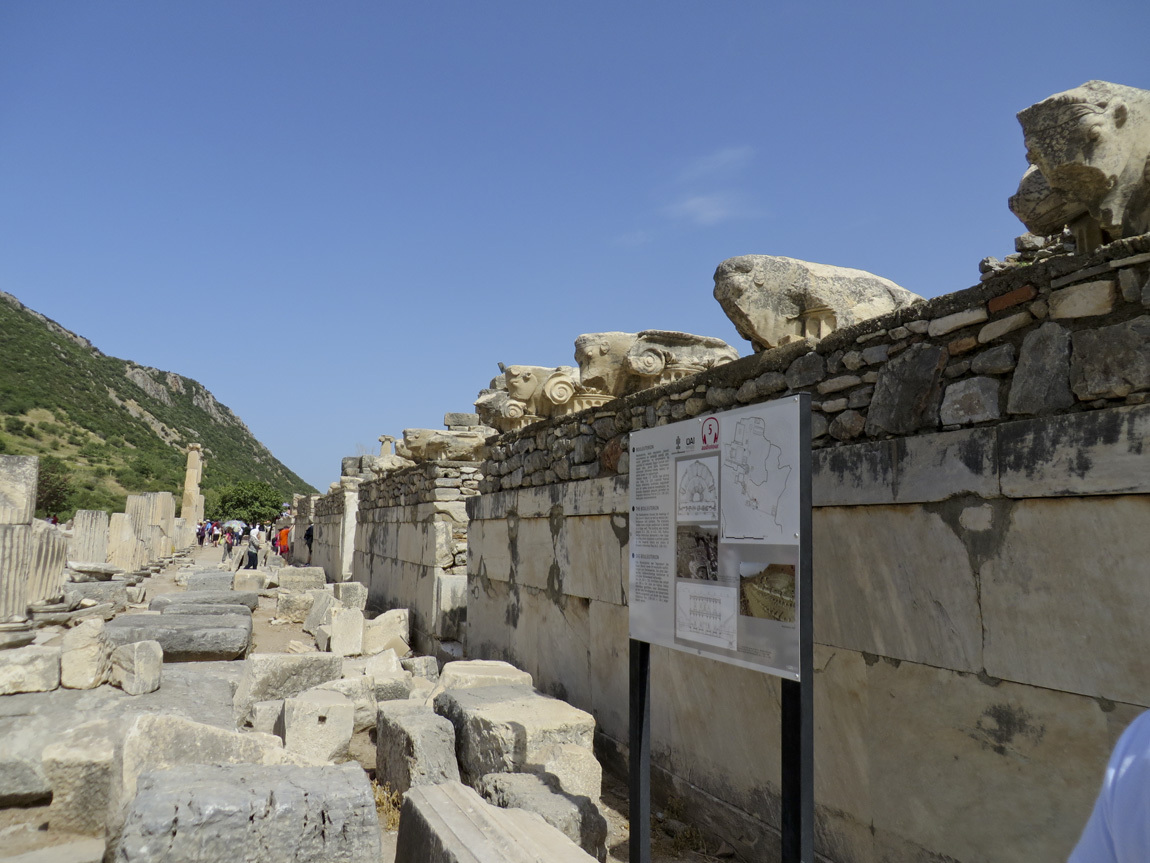
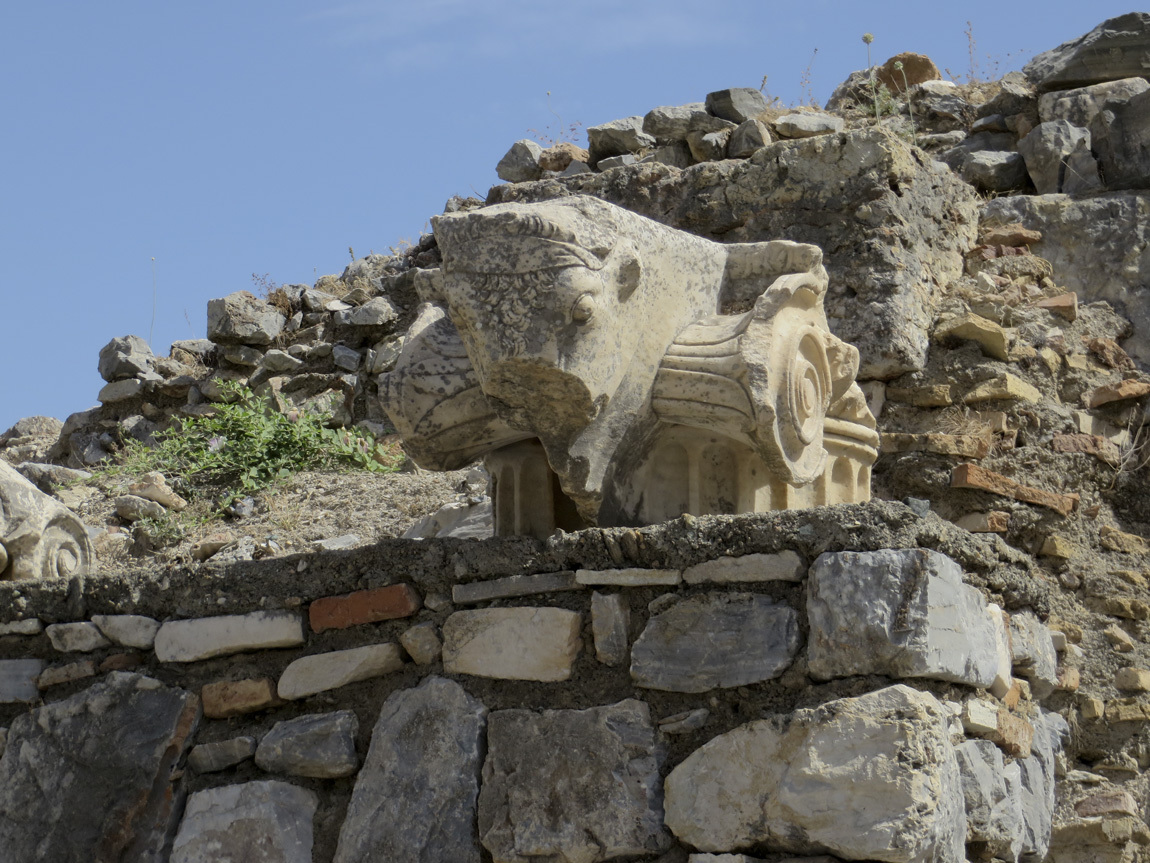
The Odeon, below, is a small theater constructed in the second century. It was used for meetings of the senate and also as a concert hall for performances. Its capacity was 1500 people; it used to be enclosed with a roof.
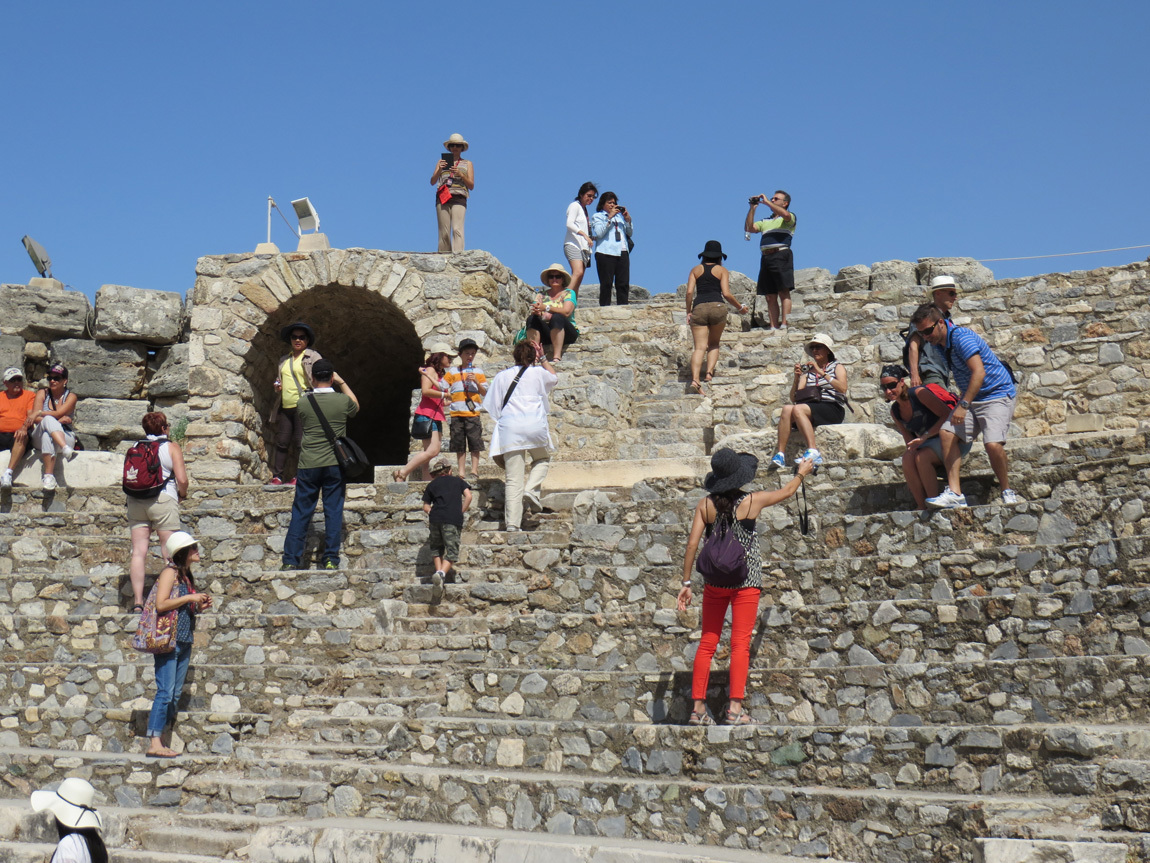
Aren't all the people taking pictures fun?
An archway after the Odeon:
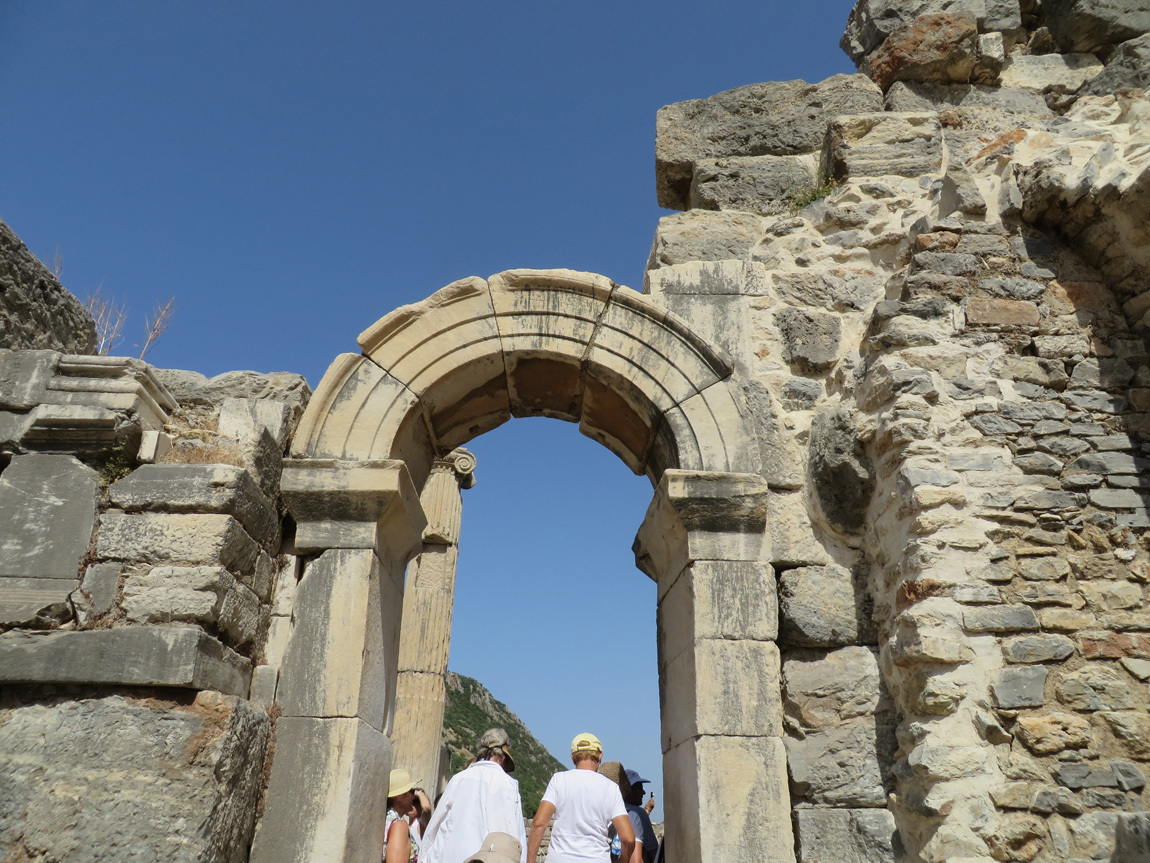
Another Turkey cat:
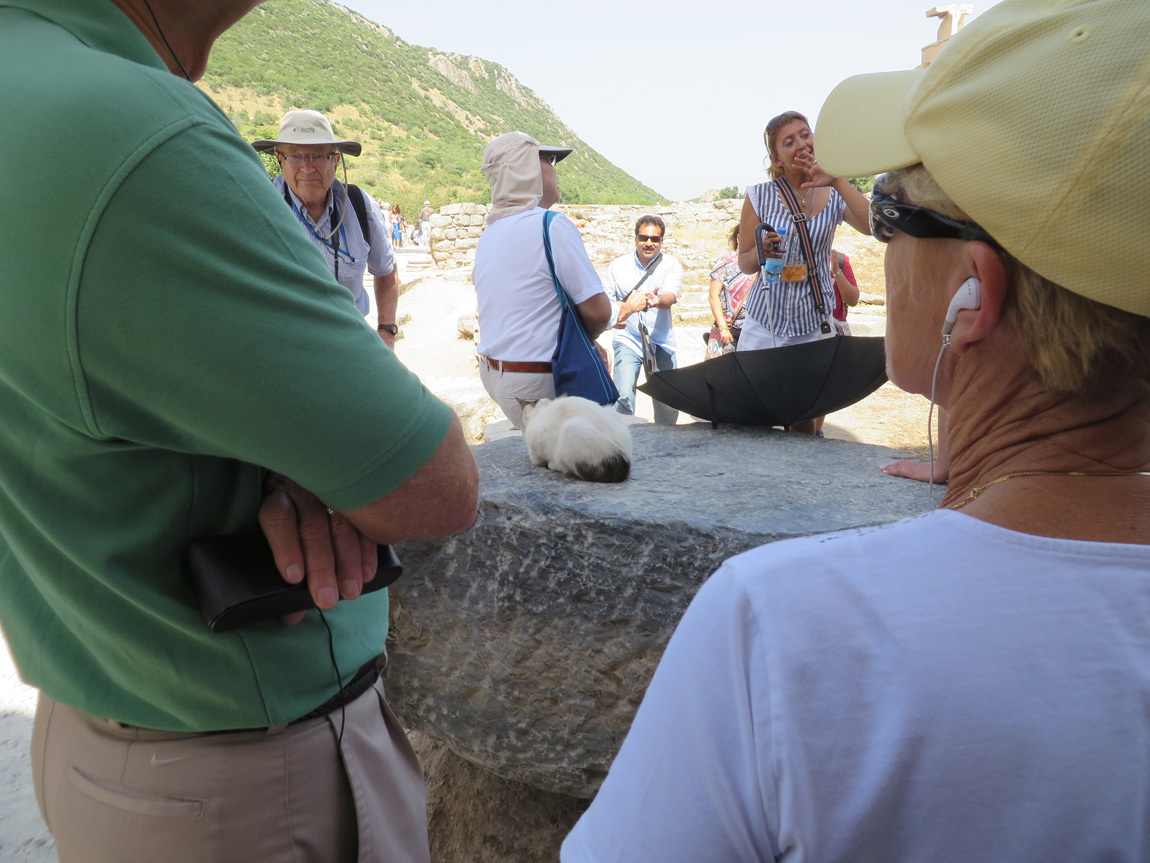
Temenos: remains of two temples erected in the first century in honor of Julius Caesar and Rome.
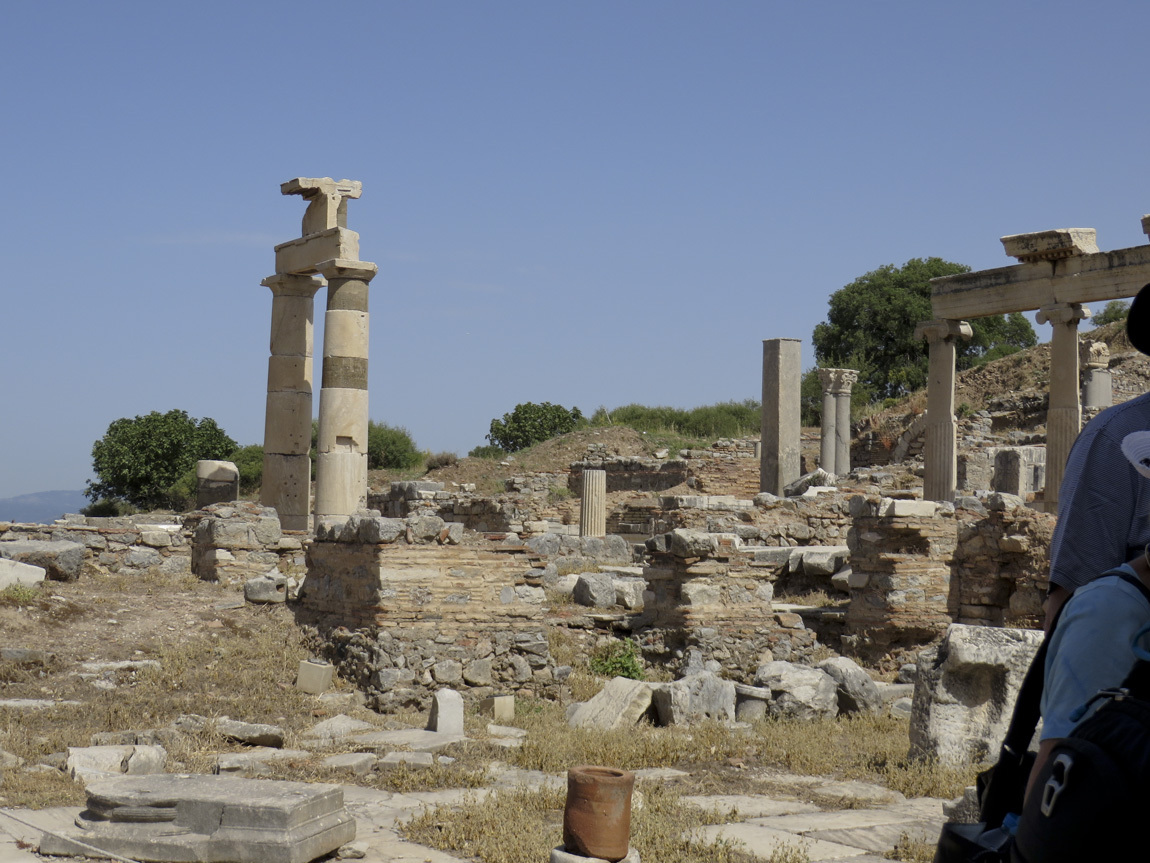
Next we come to ruins of the Prytaneion, probably built in the Augustan period (27 BC - 14 AD). The Prytaneion served as the office of the city's leading government dignitary. Tall columned porches (called peristyles) formed a courtyard. The main room of the Prytaneion was used for public banquets, and the stone blocks in the center served as either an altar or a place for food preparation. At one time two statues of Artemis were in the courtyard (now in the Ephesus Museum). (This information was on a sign at the site.)
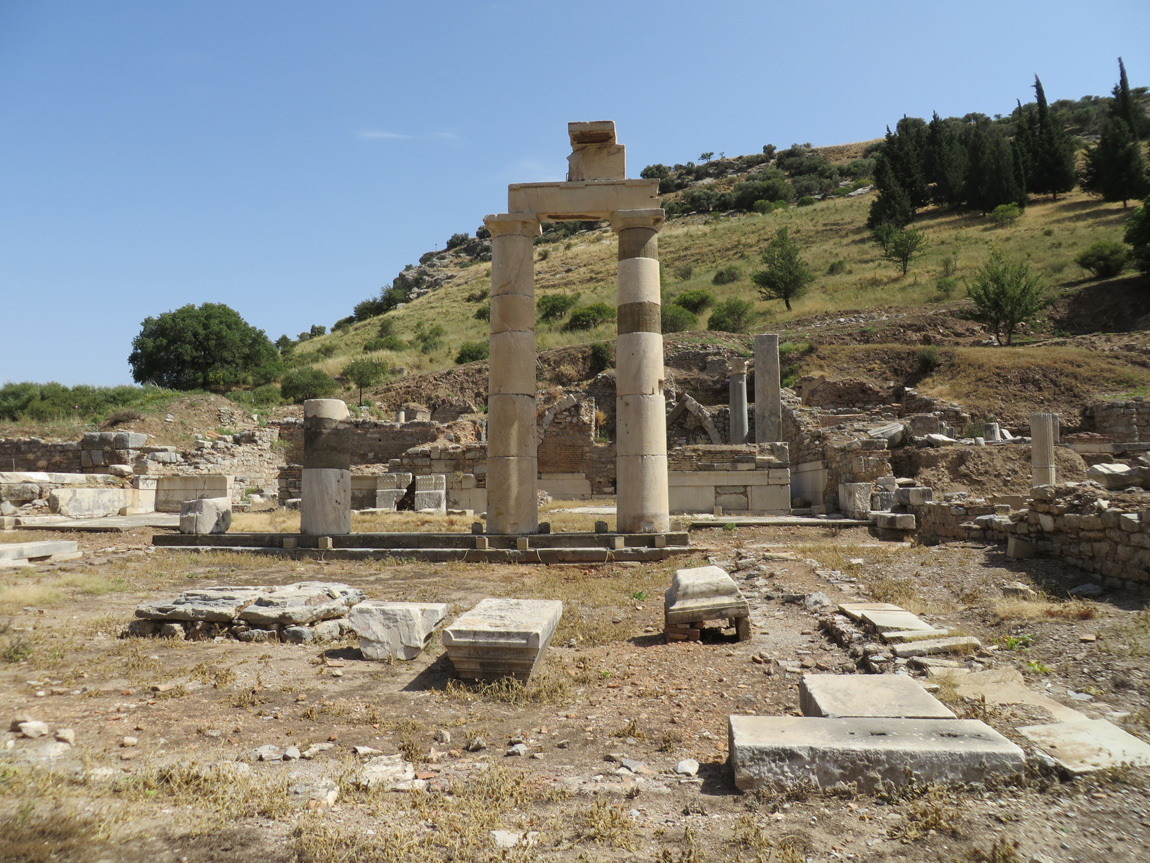
Not sure what this is, but I like it:
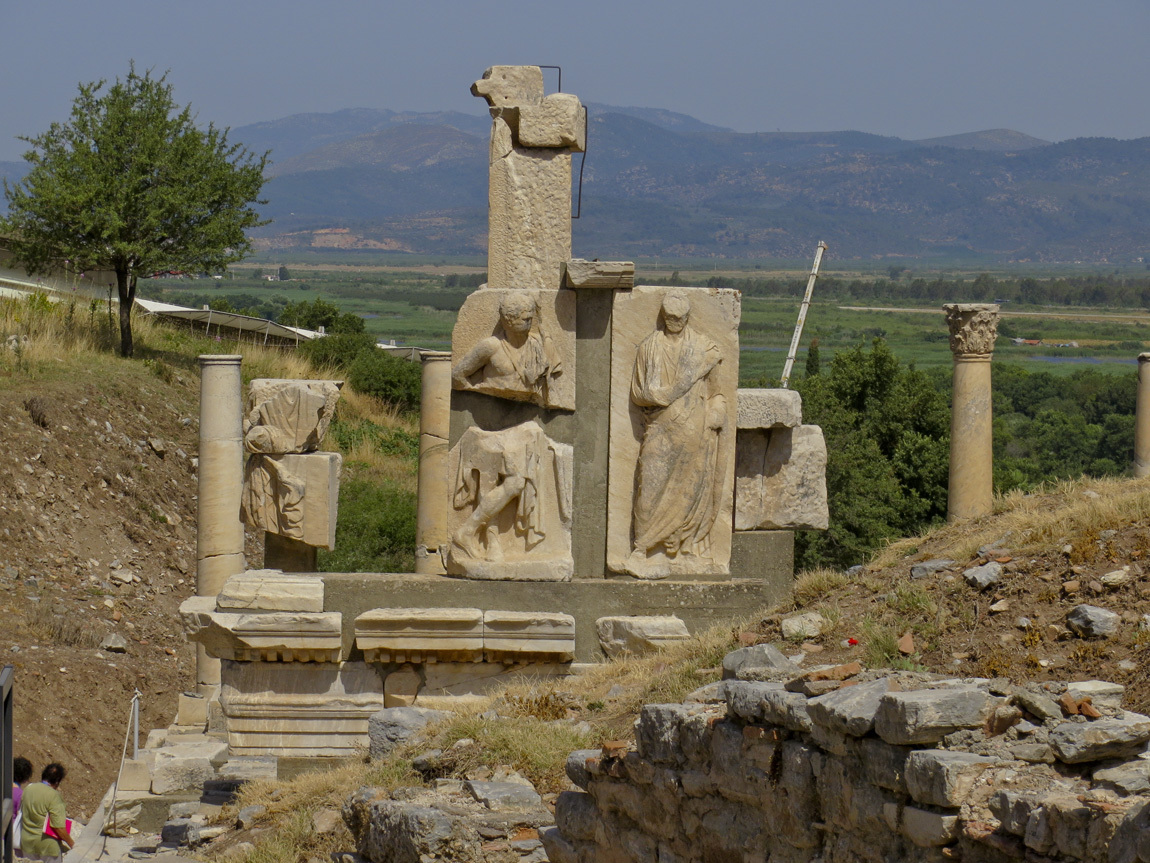
The Domitian Temple was built in honor of the emperor Domitian (81-96 AD).
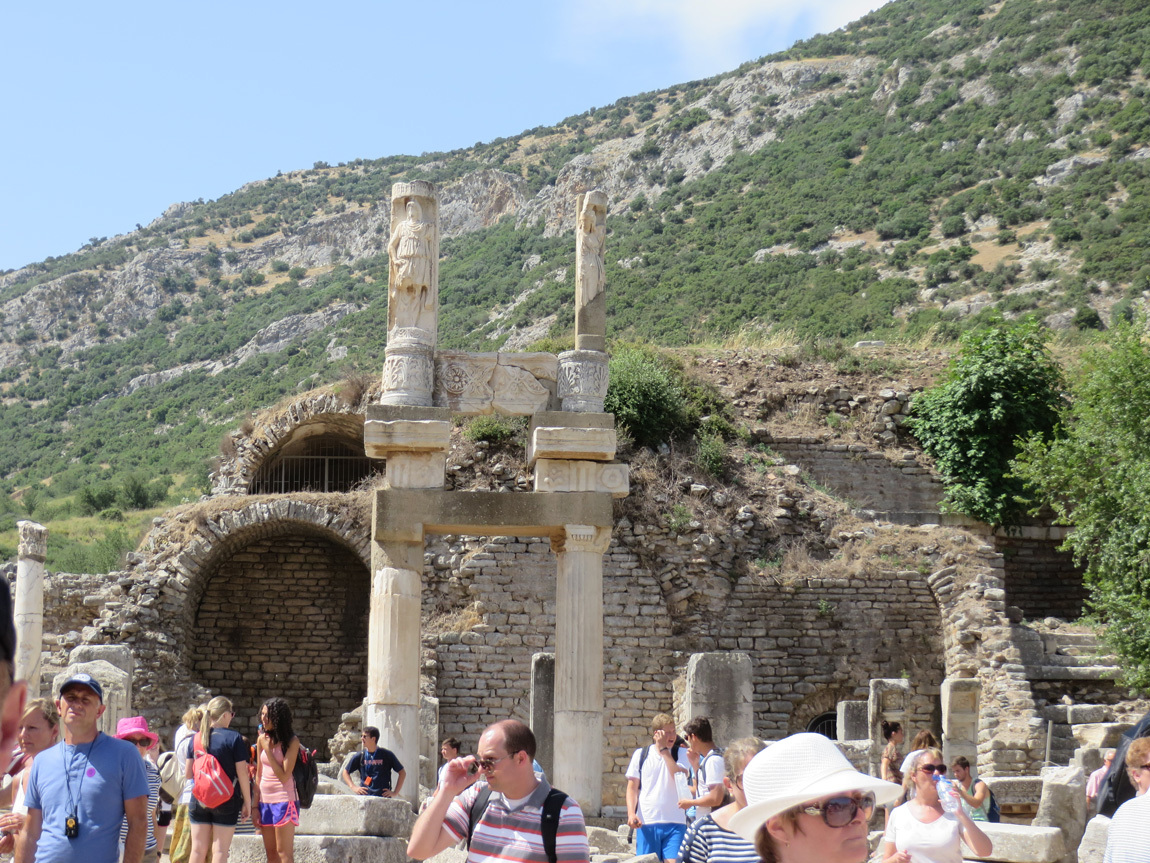
The relief of the flying Nike:
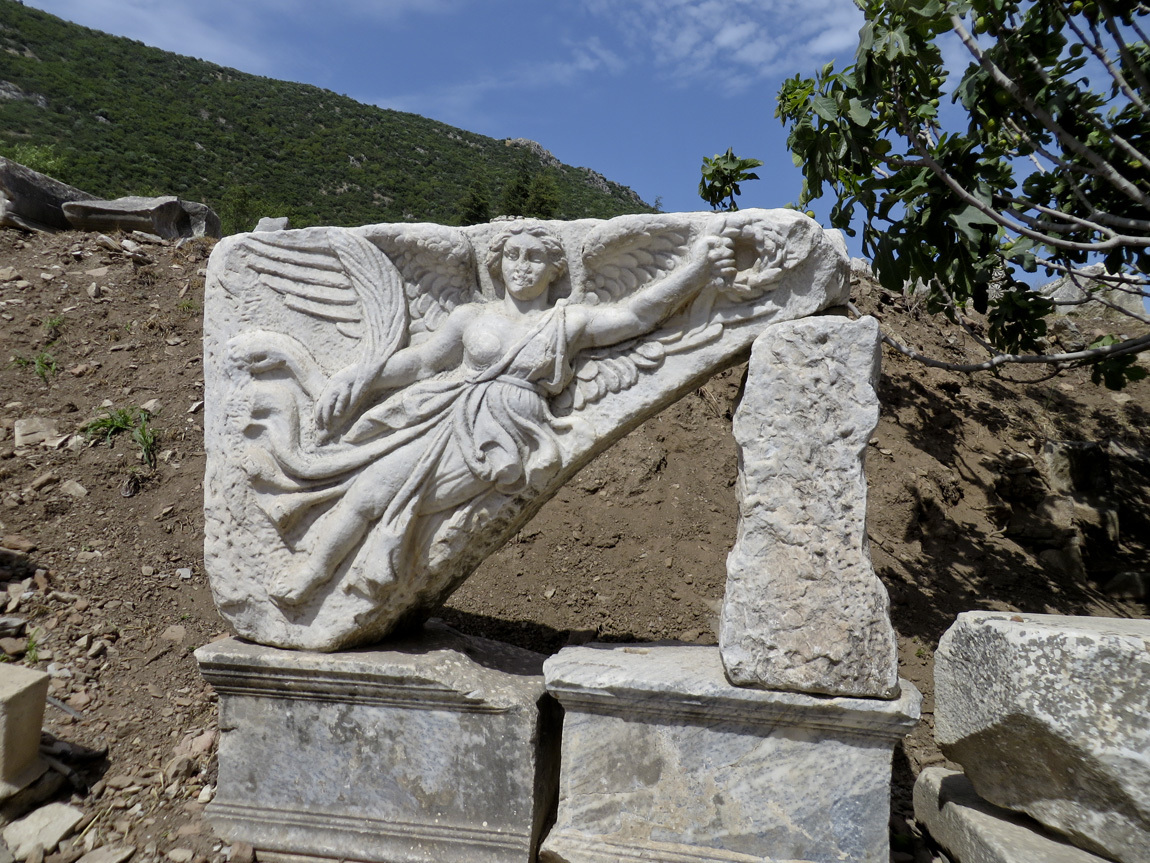
Memmius Monument:
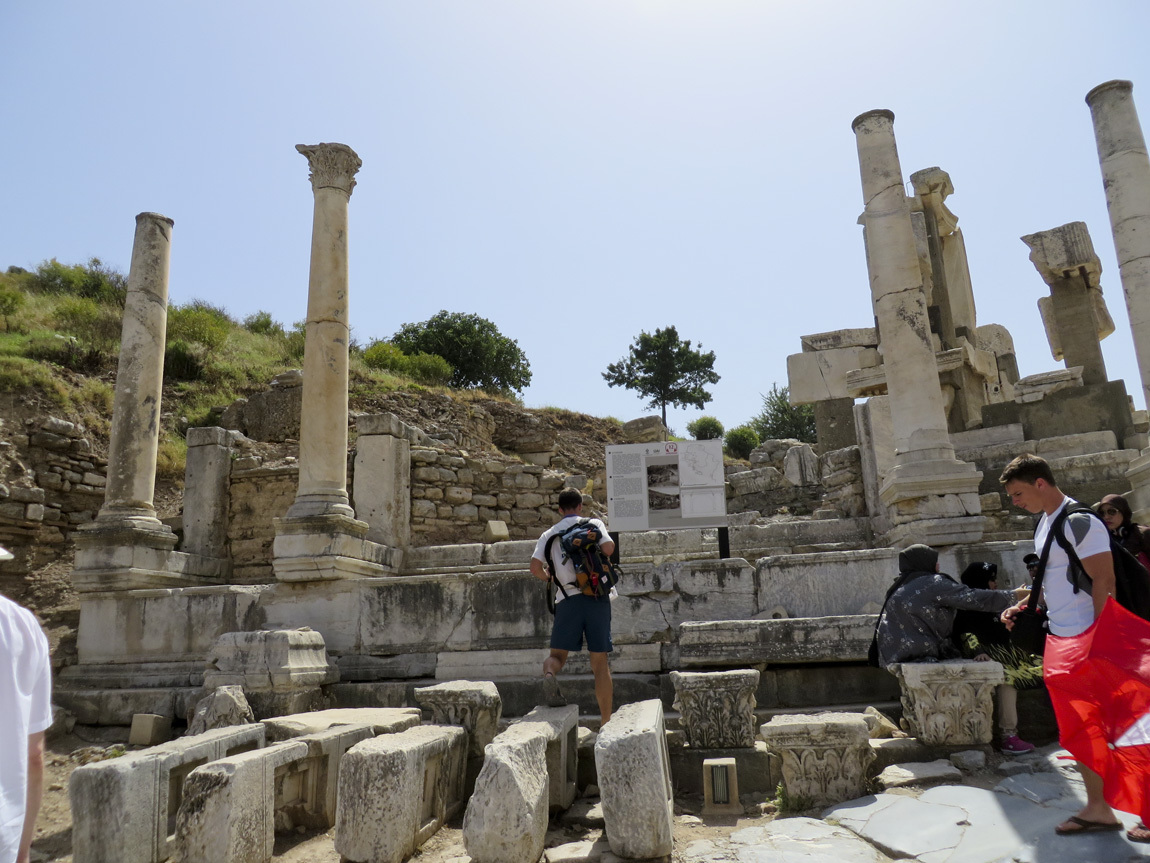
Curetes Street runs between the Hercules Gate (sorry, no photo) and the Celsus Library (photos further down). The photo directly below shows how very crowded it was the day we visited; the next photo was a wee bit later and you can see the street better:
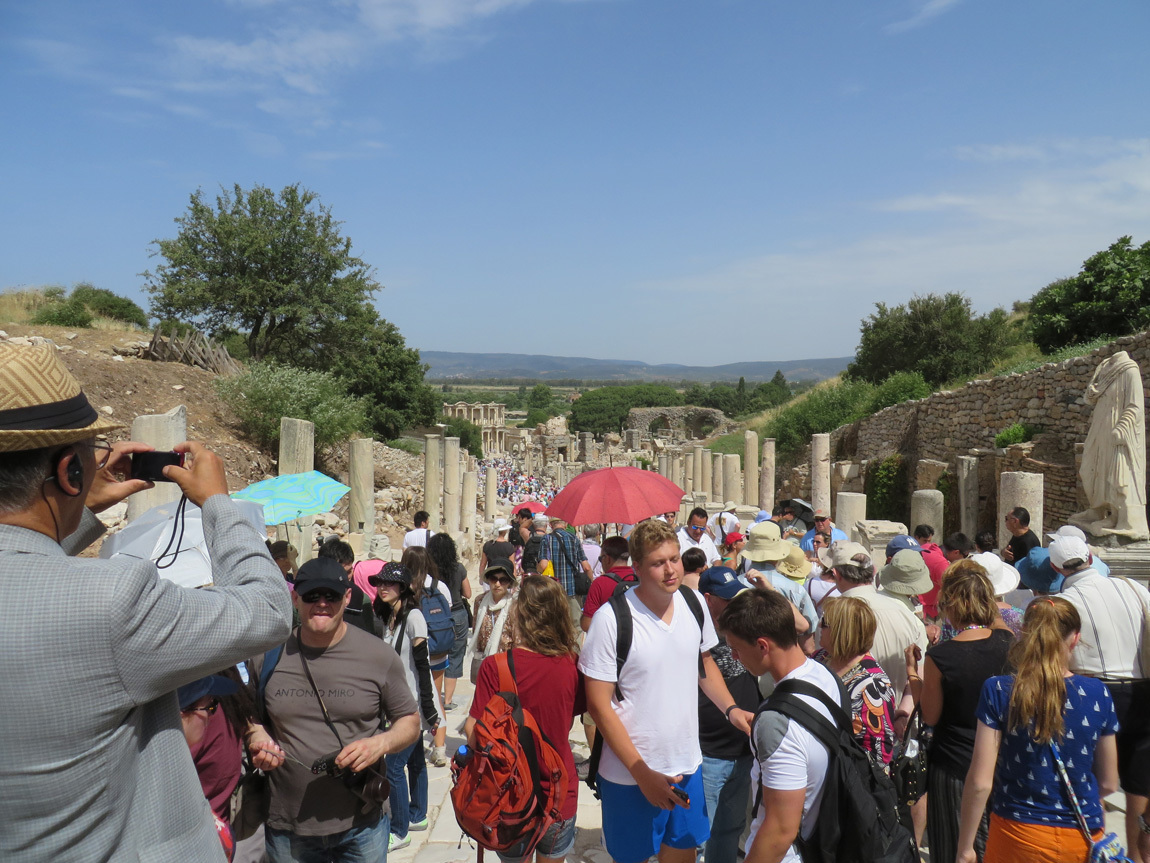
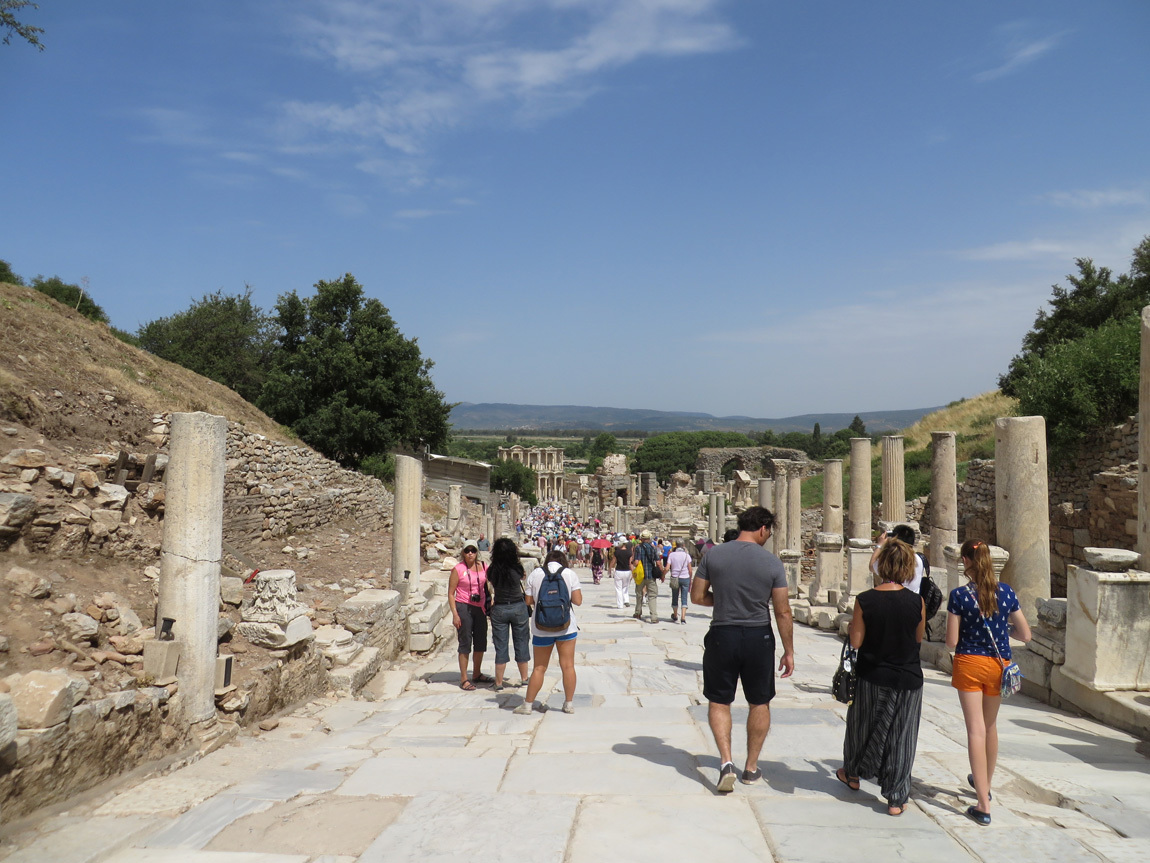
Those columns in the distance are huge! Nothing we saw at Troy, Pergamum, or the Asclepieum were close to the size. No wonder this place is so crowded.
We start walking down Curetes Street. There used to be fountains, monuments, statues and shops on the sides of the street. But many earthquakes hit Ephesus, and most structures - especially columns - were damaged. Some columns were replaced by columns from elsewhere in the city; hence, they show different designs.
Partial statue and columns along Curetes Street:
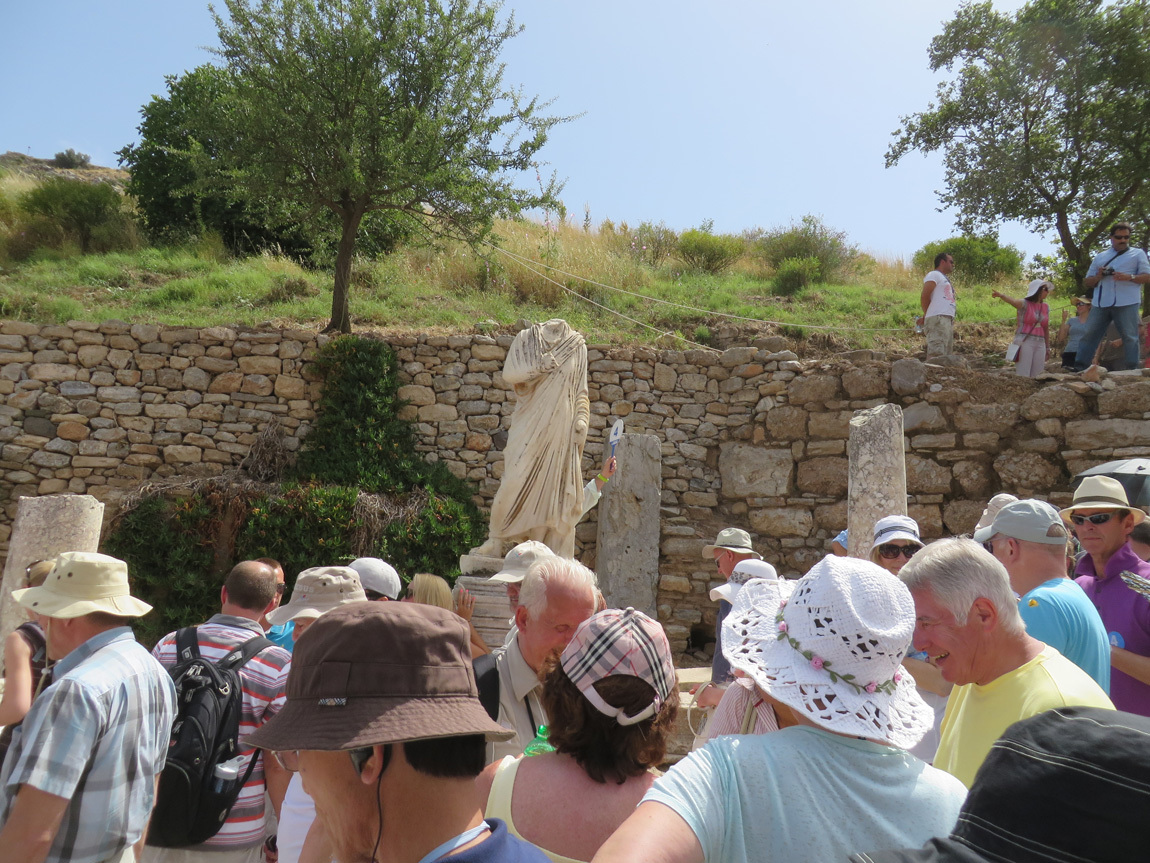
The Fountain of Trajan was built around 104 AD. Built for Emperor Trajan, his statue used to stand in the center, overlooking a pool. The pool was 20x10 meters and surrounded by columns and statues. The statues are now in the Ephesus Museum (in Turkey).
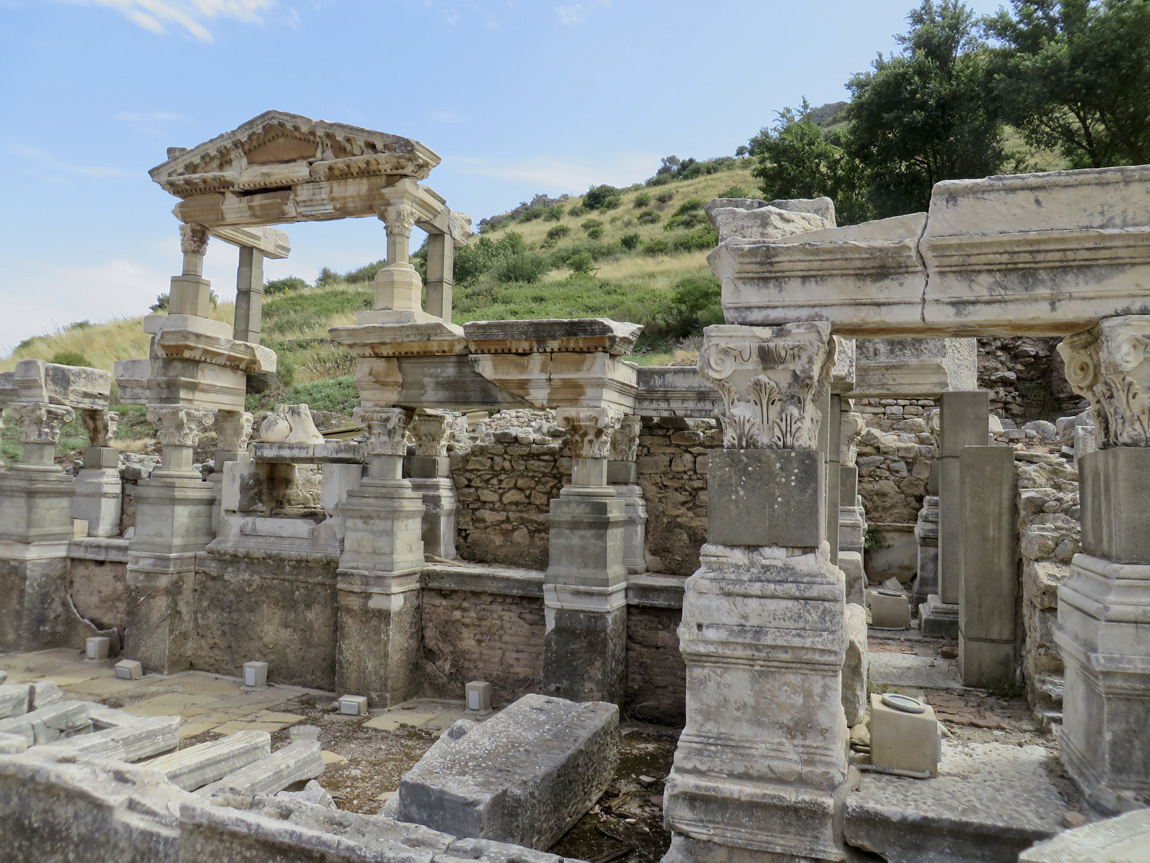
Next along Curetes Street is the Temple of Hadrian. Hadrian was one of the "Five of Good Emperors" of the Roman Empire. During his reign (117-138 AD), there were not a lot of military actions; he ruled through strength rather than campaign. Hadrian was a patron of the arts, and he admired Greek culture. He visited Ephesus in 128 AD, and the Temple of Hadrian was built soon thereafter. It's amazing to realize that the Roman empire once reached all the way from past Turkey to Great Britain (known as Roman Britain at the time), as marked by Hadrian's Wall. One can only imagine how difficult it was to rule such a large empire back when transportation and communication were so slow.
The facade of the Temple of Hadrian has four Corinthian columns supporting a curved arch. The side columns are square. We try to imagine what it used to look like. Then Ali pulled out this neat museum book that showed how each ruined structure looks now, and then had an overlay page that showed how it looked in its prime. That was cool.
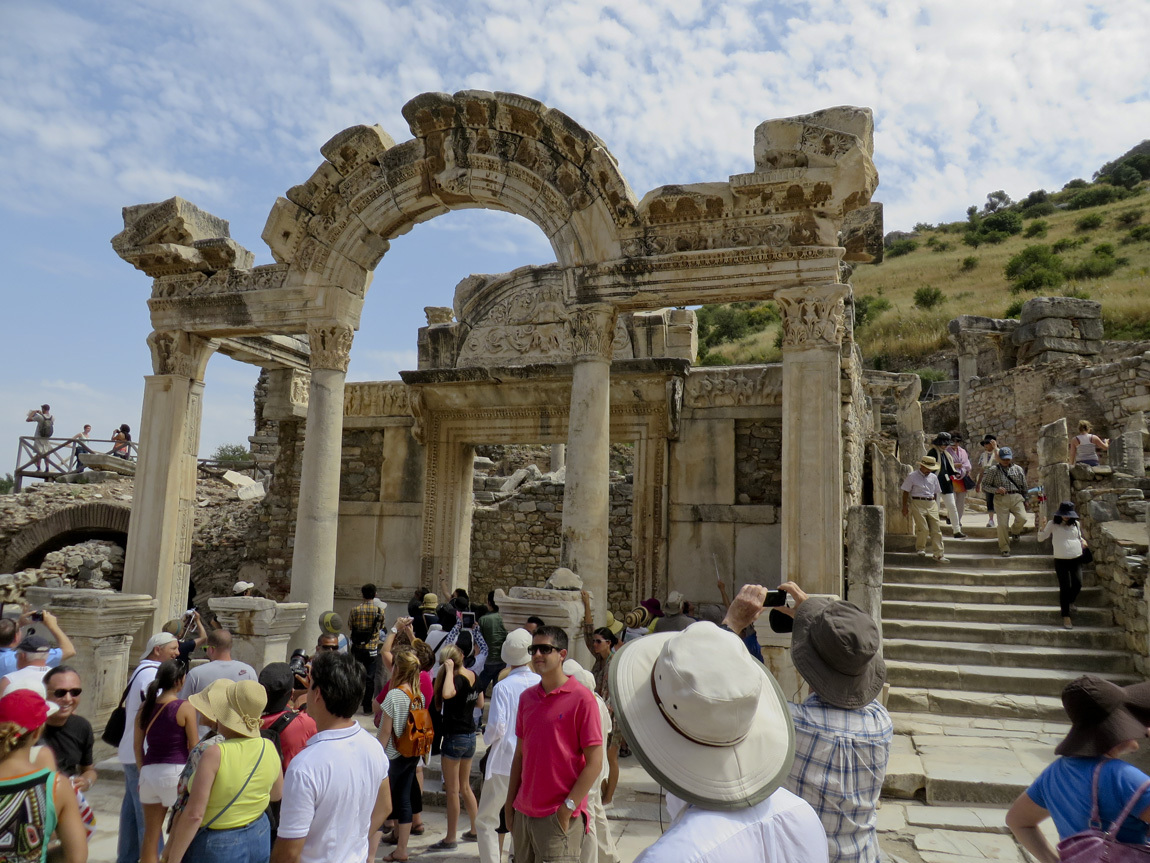
In the middle of the arch is a relief of Tyche, the goddess of victory.
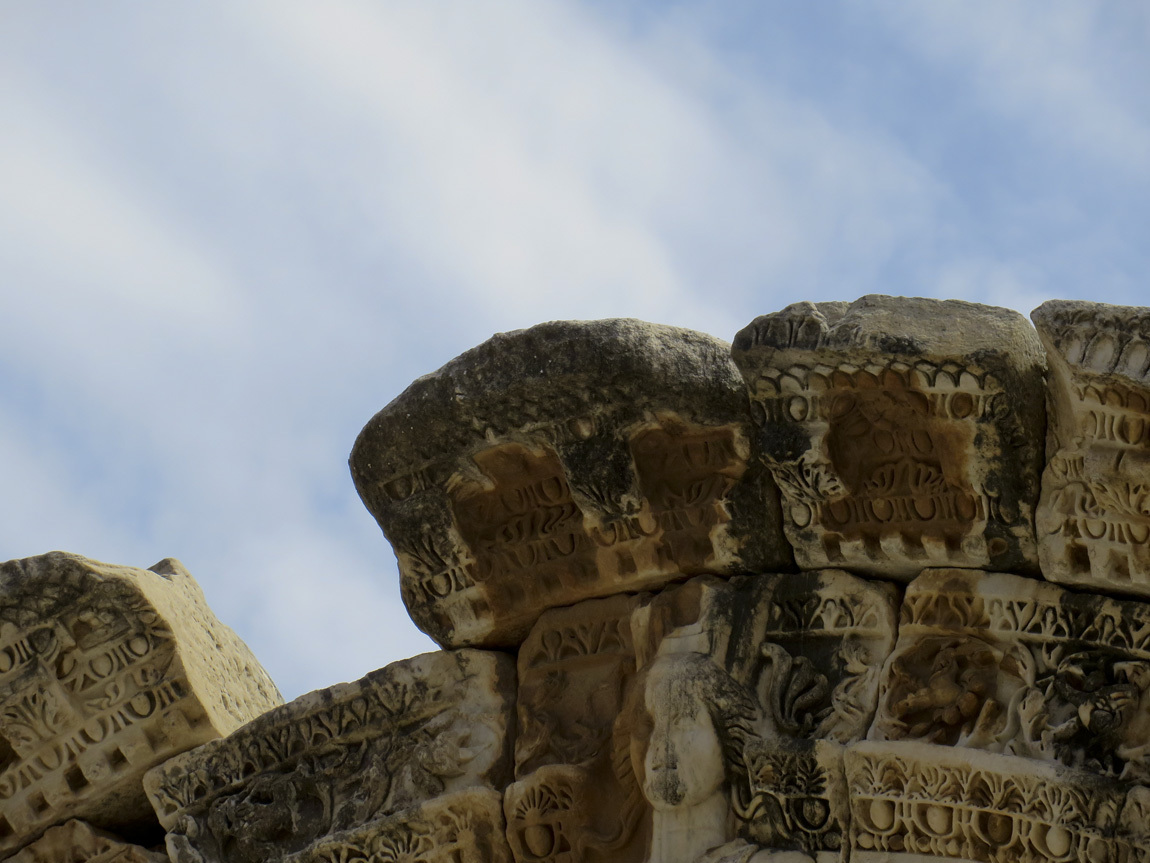
Inside the temple is a human figure, probably Medusa:
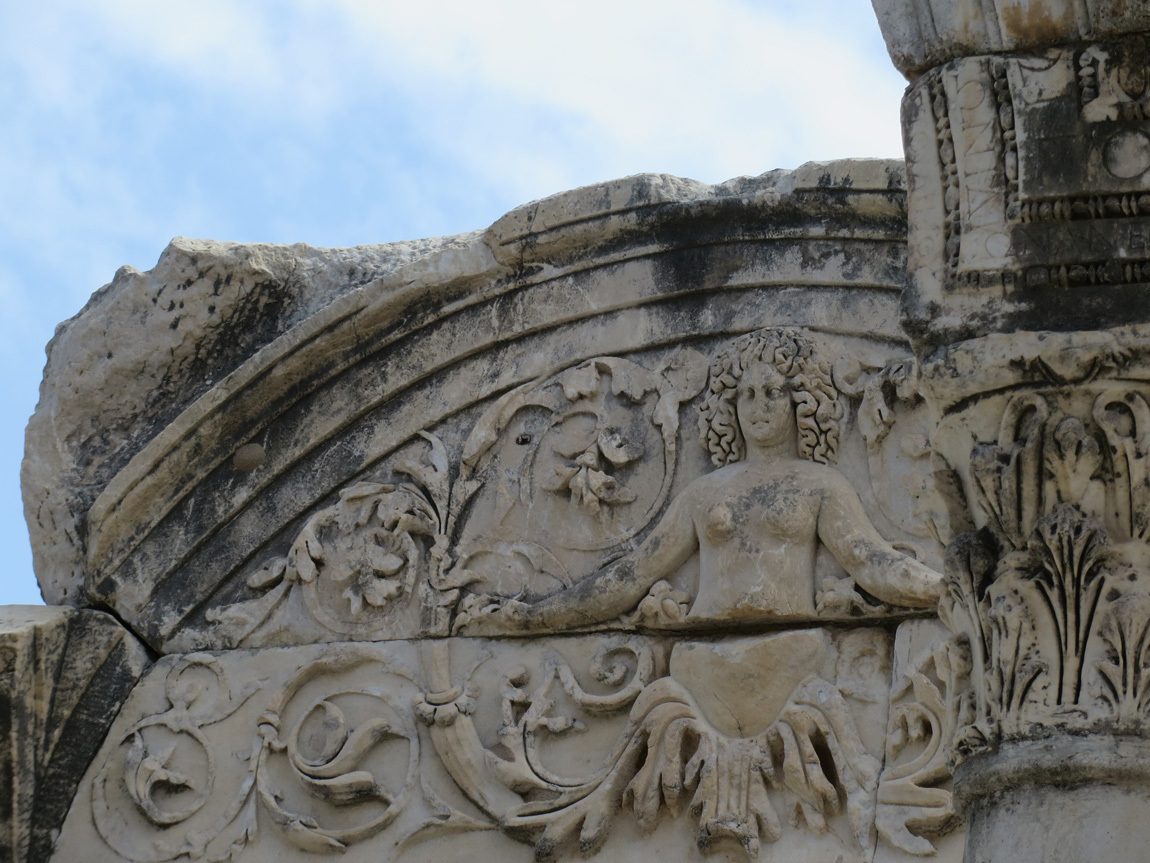
On both sides of the Medusa there are friezes depicting the story of the foundation of Ephesus. This photo shows the left side - Androklos shooting a boar, Dionysus in ceremonial procession and the Amazons. These friezes in the photos are only copies; the originals are displayed in Ephesus Museum.
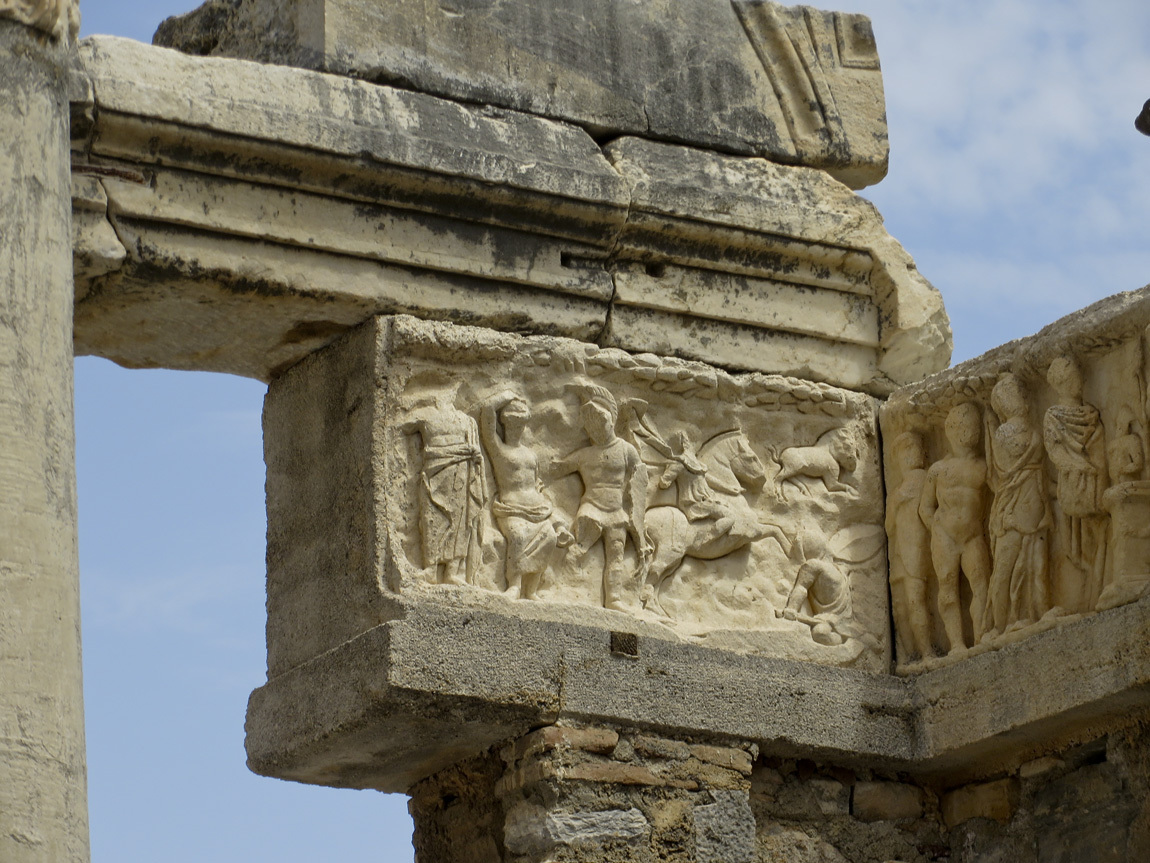
Can you guess what these are?
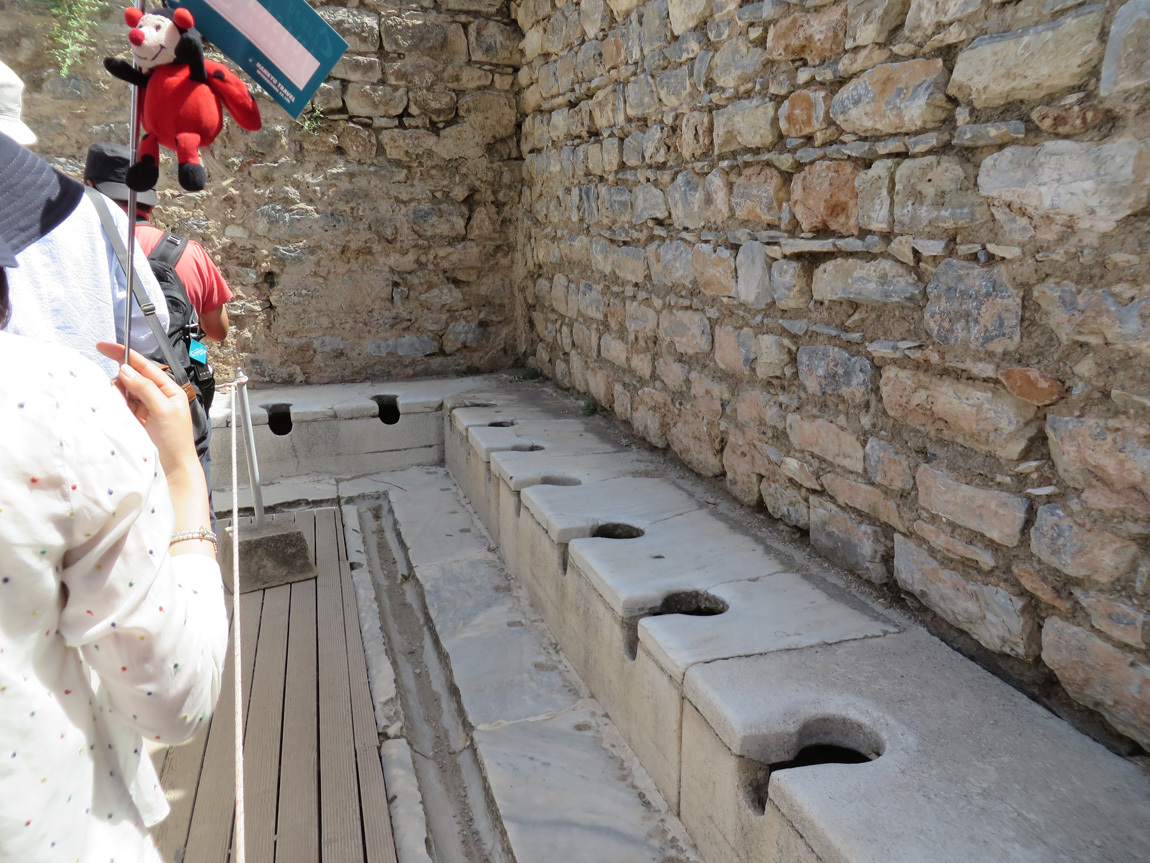
If you said "latrines" or something like that then you are right. The toilets are aligned along the walls, and there used to be a pool in the middle of the building. I seem to remember Ali saying these toilets were only for the elite, but this web site says they were the public toilets and there was an entrance fee to use them. Built in the first century, a canal system brought in water was in and there was a drainage system under the toilets. Hot air forced through these large clay pipes heated the walls.
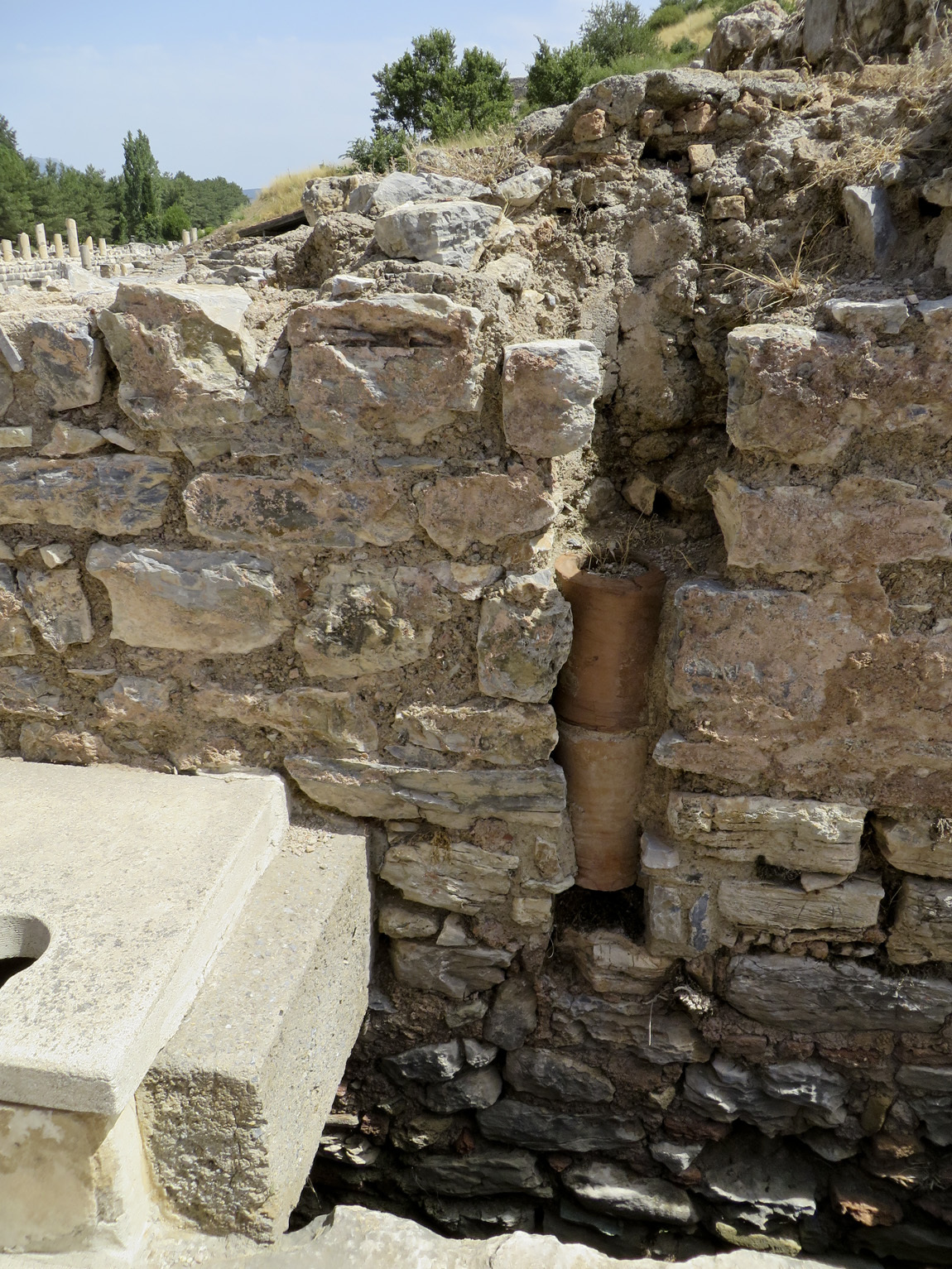
We've been at Ephesus about an hour. Here is a look down hot and crowded Curetes Street:
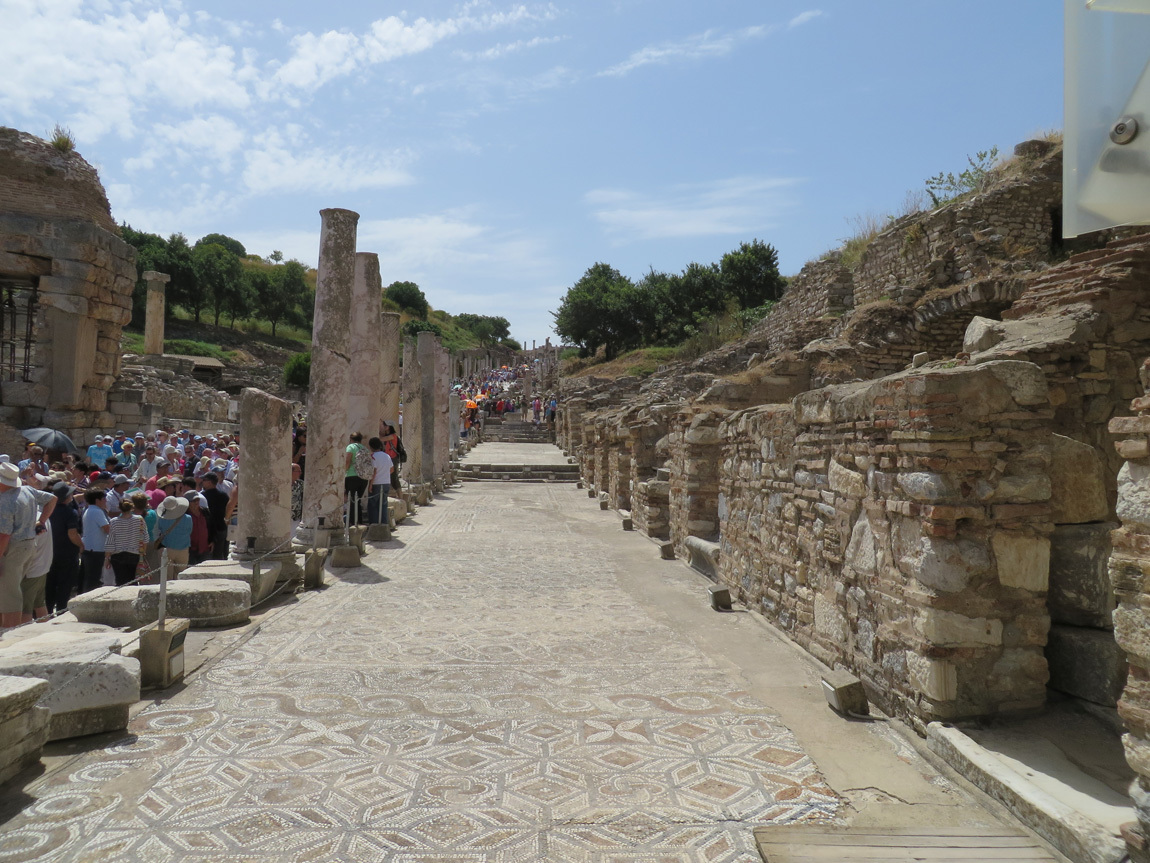
We don't go back down Curetes Street quite yet. Ali has arranged for us to visit a special exhibit, the Terrace Houses, on the hill opposite Hadrian's Temple. This is a museum and an active restoration at the same time. The entire area is covered with a roof supported by scaffolding - a nice break from the unrelenting sun.
The Terrace Houses are where the elite of Ephesus lived. Built in the early Roman Imperial period (ca 20 AD), the units are multi-storeyed with tall, open interior courtyards framed by columned porches ("peristyle"). Living and work spaces were arranged around the courtyards. Rooms were heated by hot air carried by clay pipes beneath the floors and behind the walls. Hot and cold water was supplied and drained through a system of wells and canals. There were toilets and kitchens. Civilization!
The Terrace Houses were once richly decorated with mosaics and frescos. At the time of our visit, two of the houses had been partially restored by consolidating mosaics and frescoes from all of the original dwellings. The photo below shows a peristyle courtyard, the restoration supports, and tables full of pieces of walls, floors, frescos and art that are being fitted back together, like a big puzzle:

This spacious and high room is called the "Marble Hall". According to a sign at the museum, "around 100 AD it received marble furnishings on the walls and floors, a niche fountain at the back wall and a central basin. The banqueting hall provided a luxurious setting for both private and official occasions, and presented the social status and prosperity of the landlord plainly to every guest."
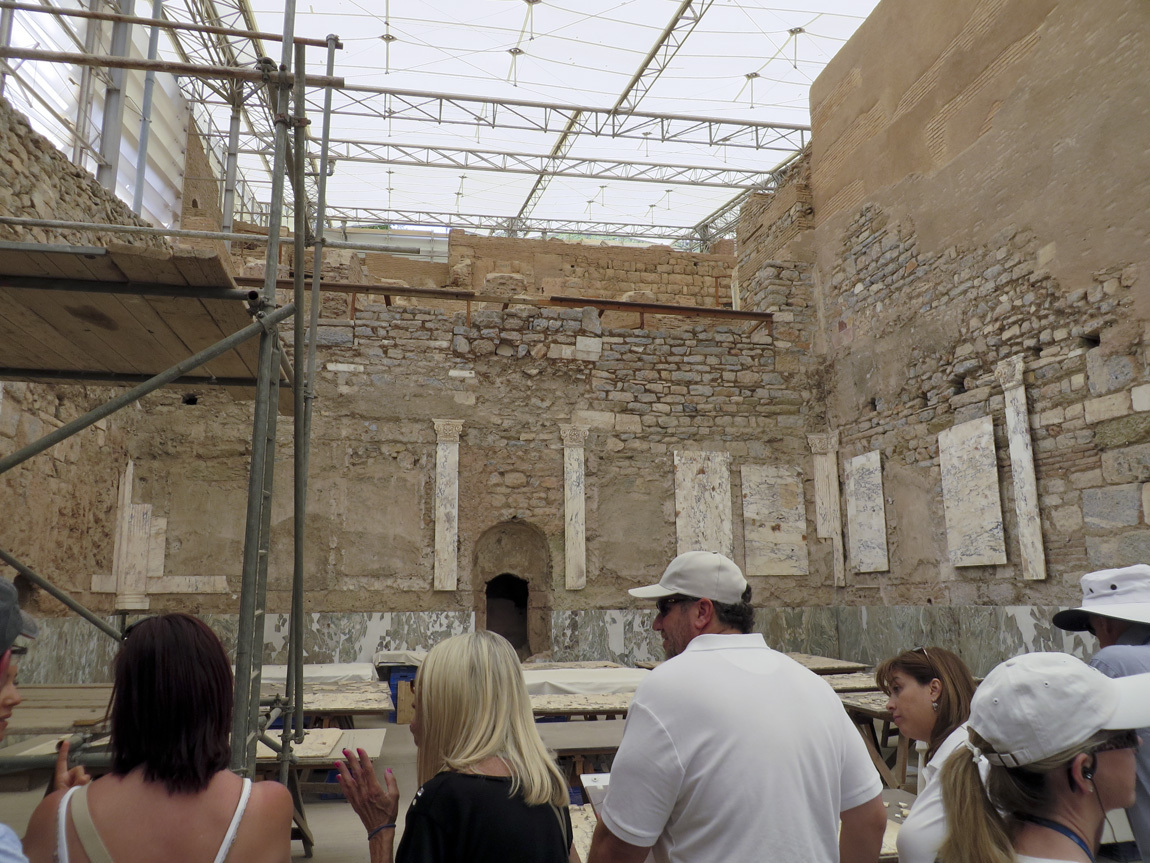
An example of a marble wall decoration being pieced back together:
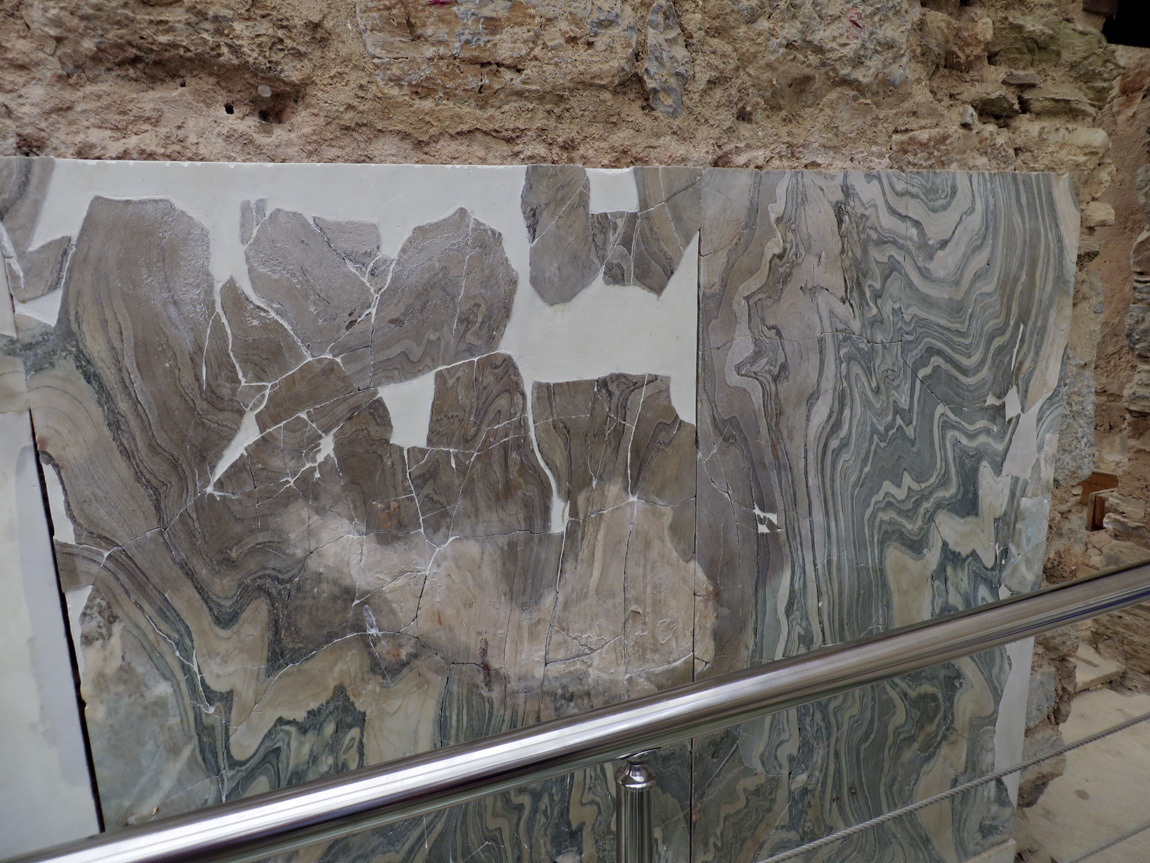
Not sure what this led to:
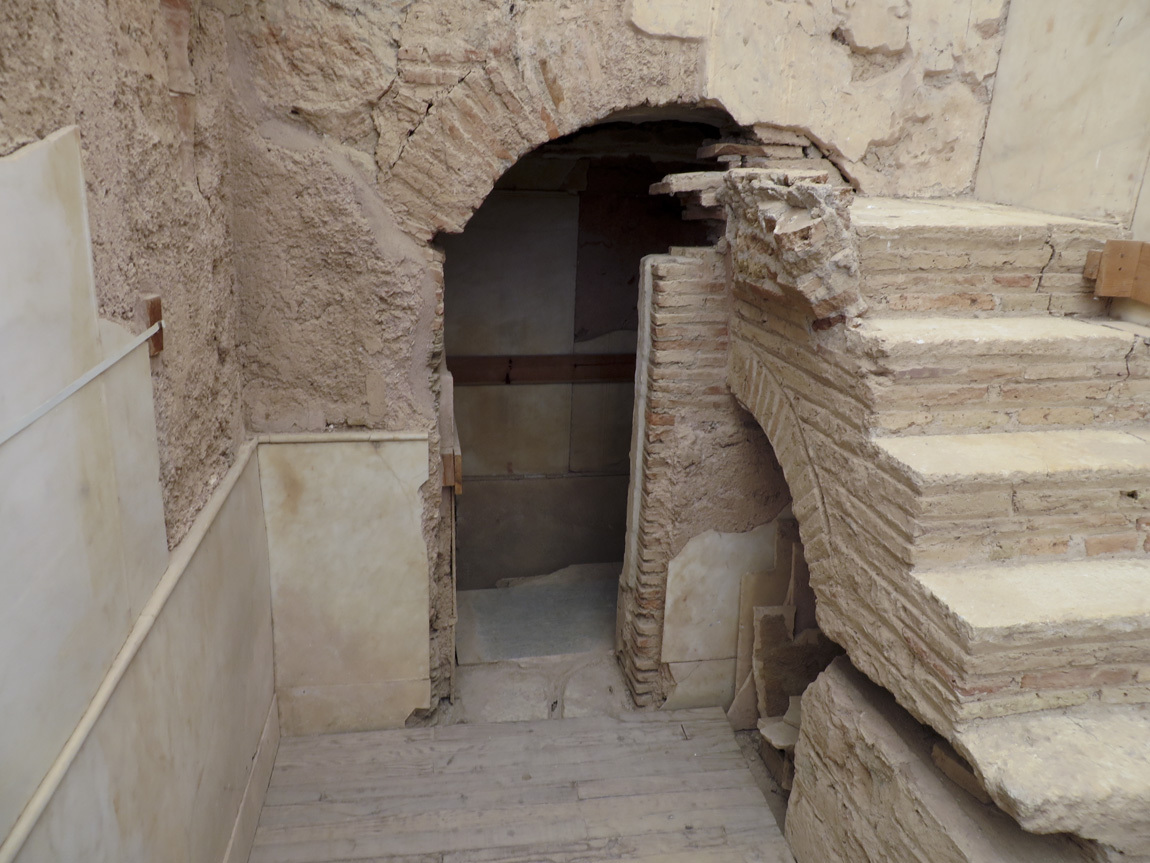
Wall art:
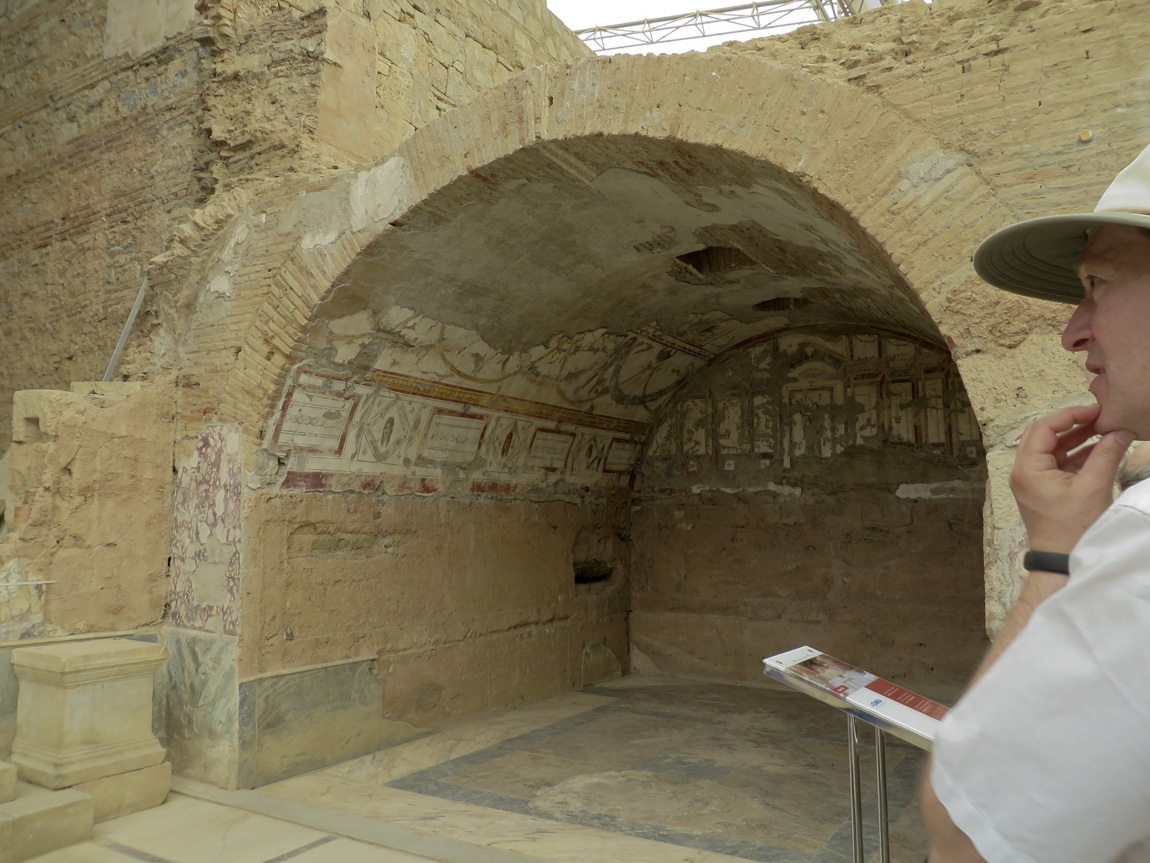
This museum worker doesn’t seem too happy to see us:
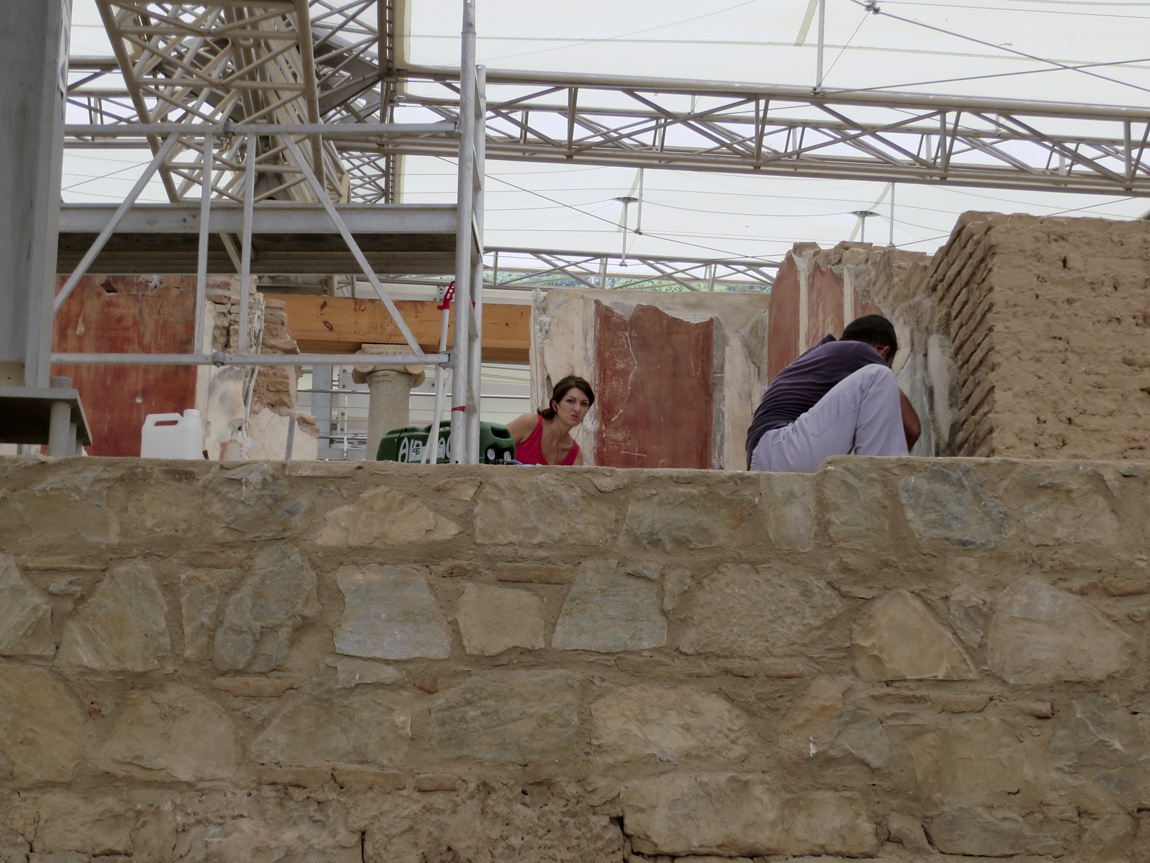
Looking down:
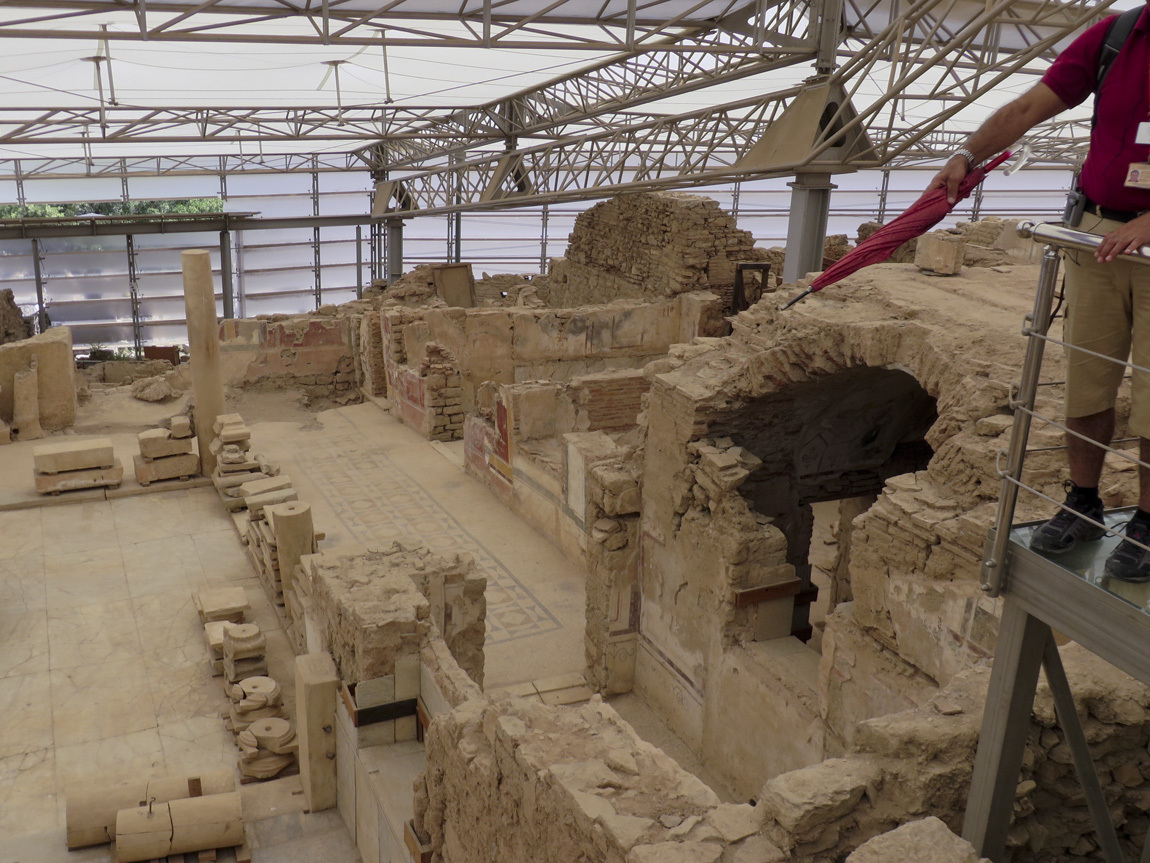
Wall art:
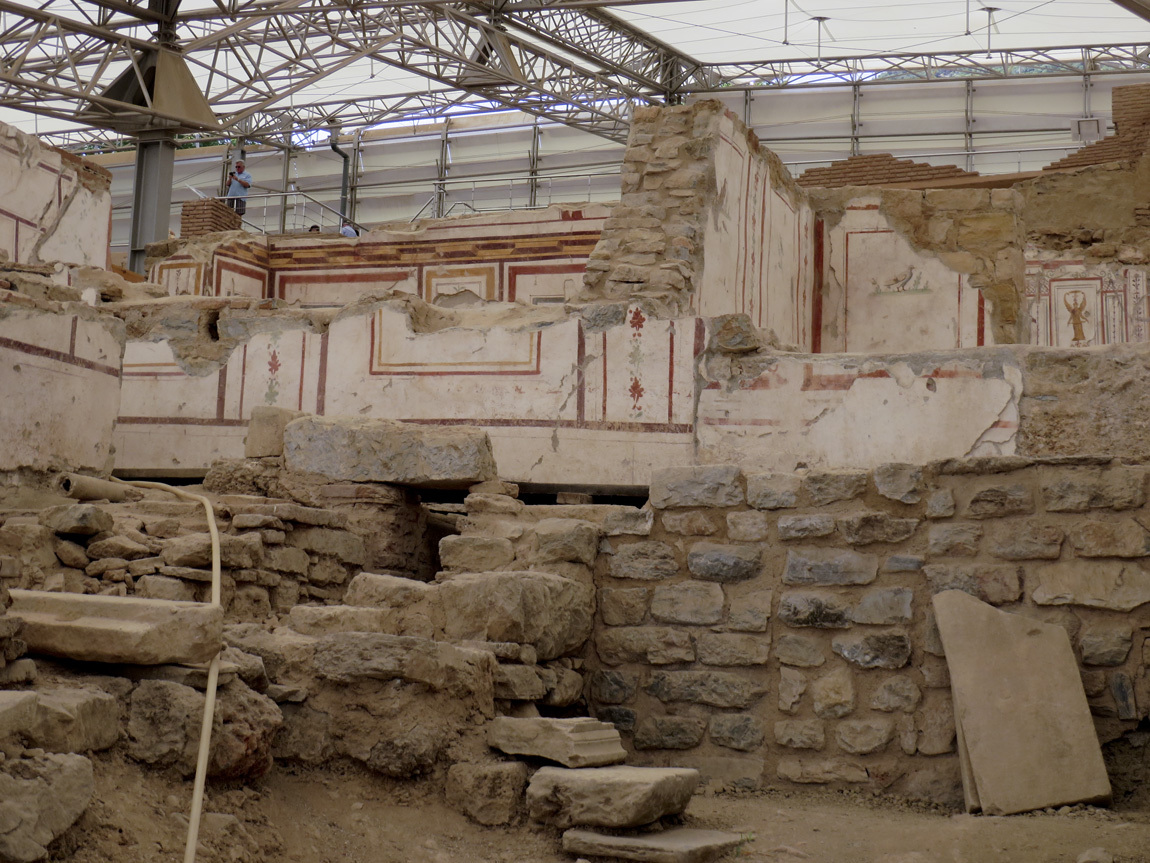
Restoration in progress:
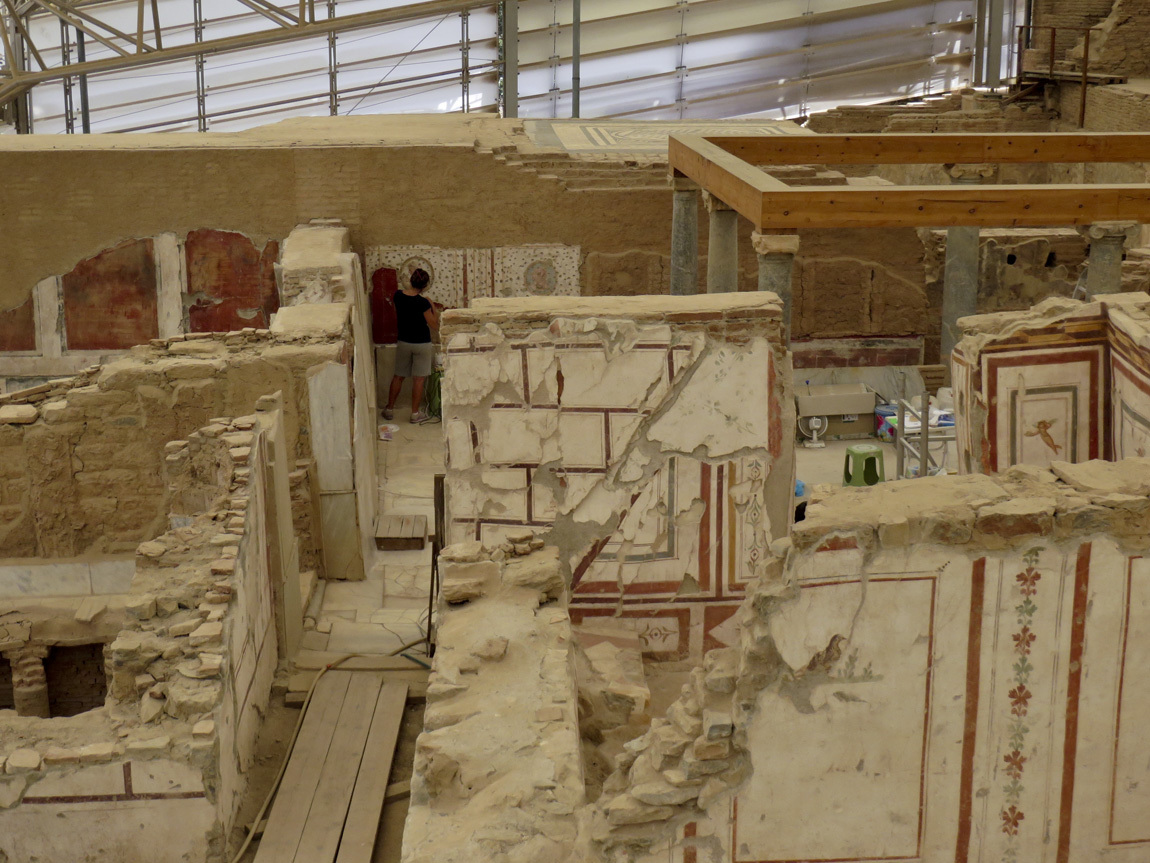
A lion mosaic on the floor:
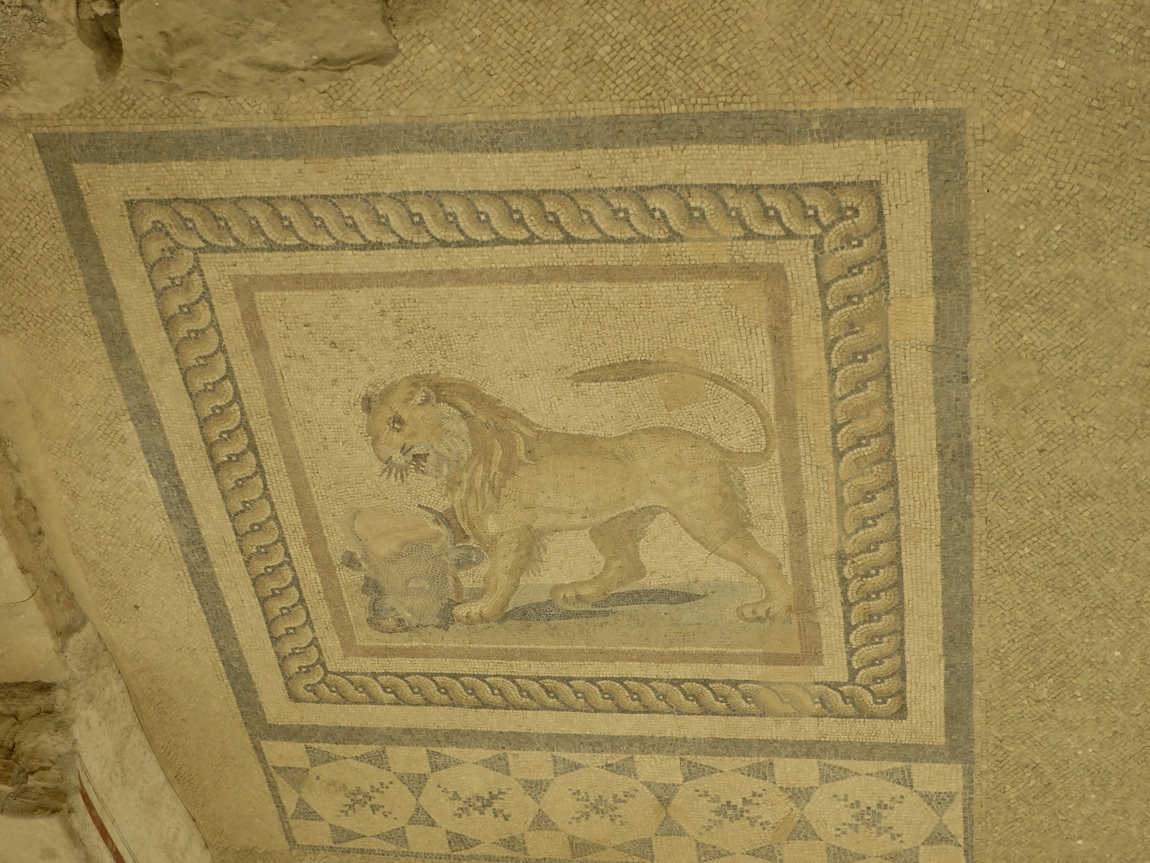
A corner that shows wall art as well as water and heater pipes:
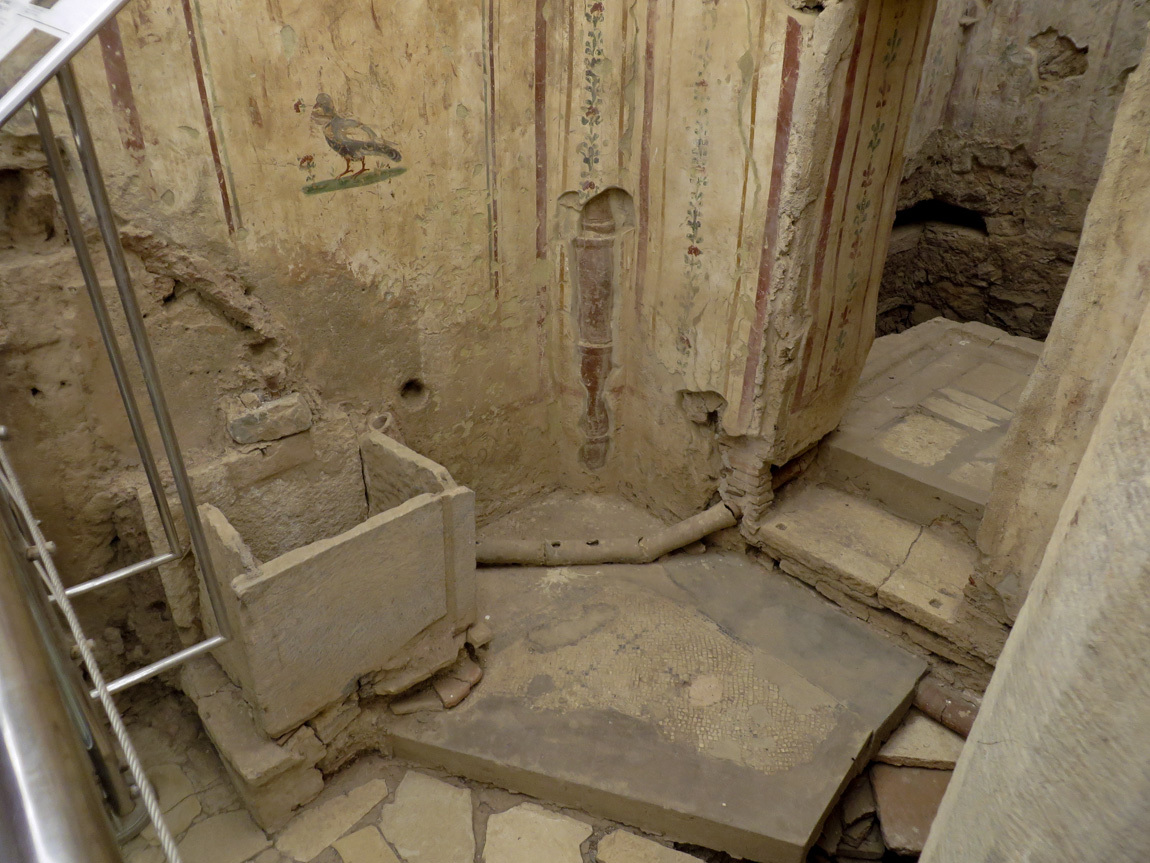
Courtyard, partially restored:
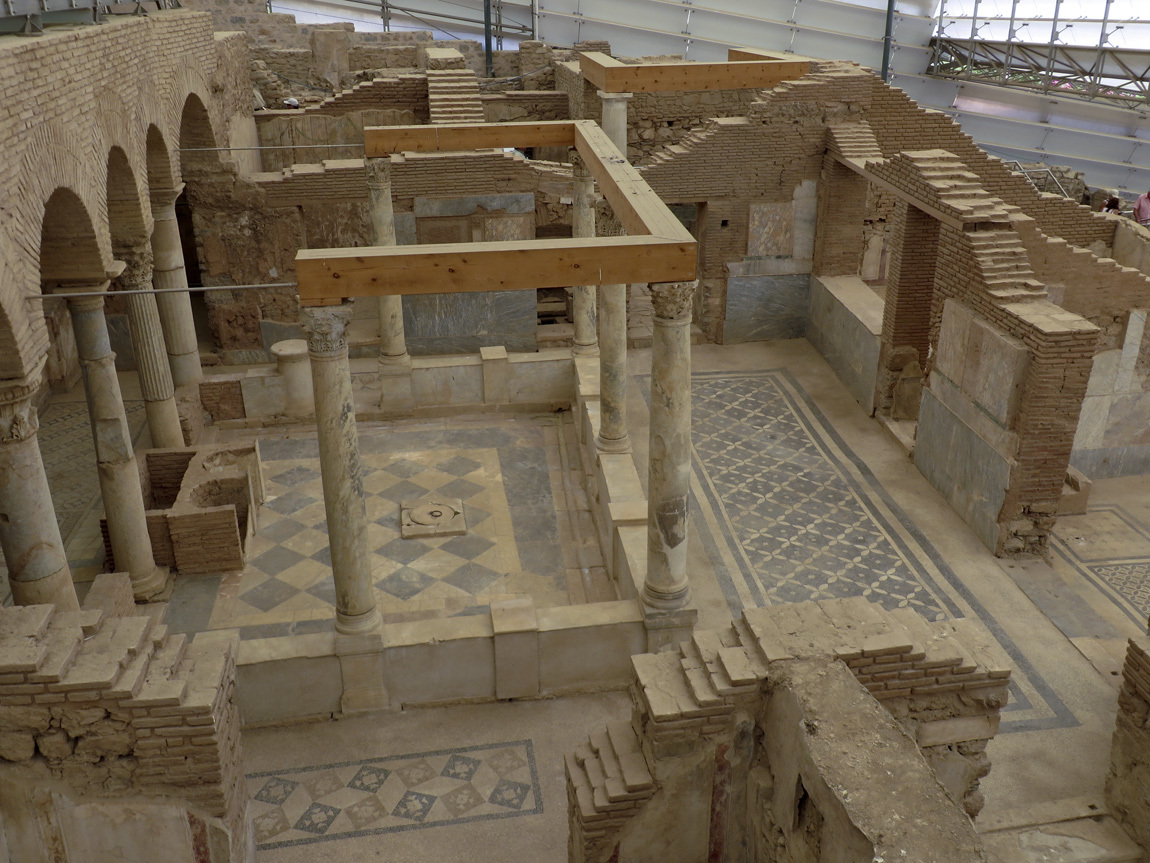
A series of earthquakes in the 3rd century AD put a sudden end to the dwellings in the city center of Ephesos. An extensive reorganization of the area took place in the early 7th century, when an early Byzantine handicraft quarter with mills, smithies and potteries was established over the Roman residential building. (Information from the signs in the museum.)
View from the hillside, where we exited the Terrace Houses:
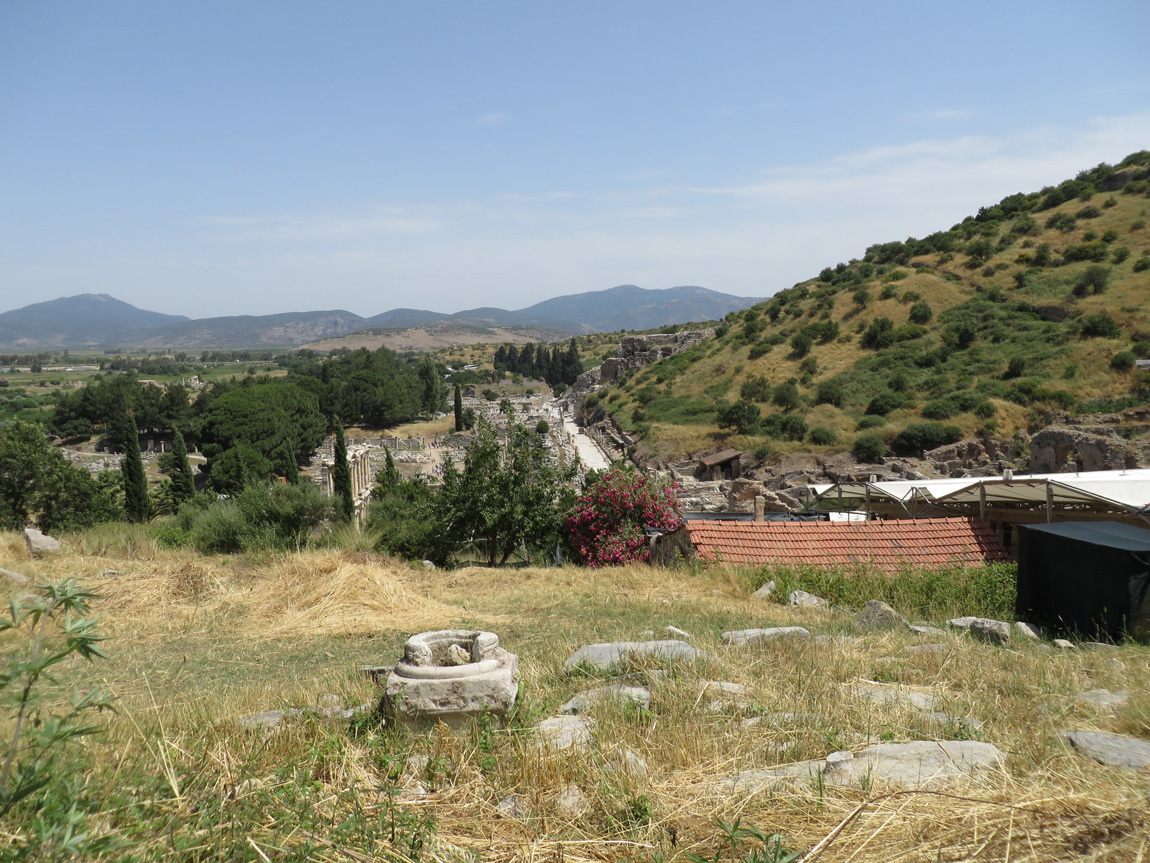
Here we are, in our Turkey floppy hats:
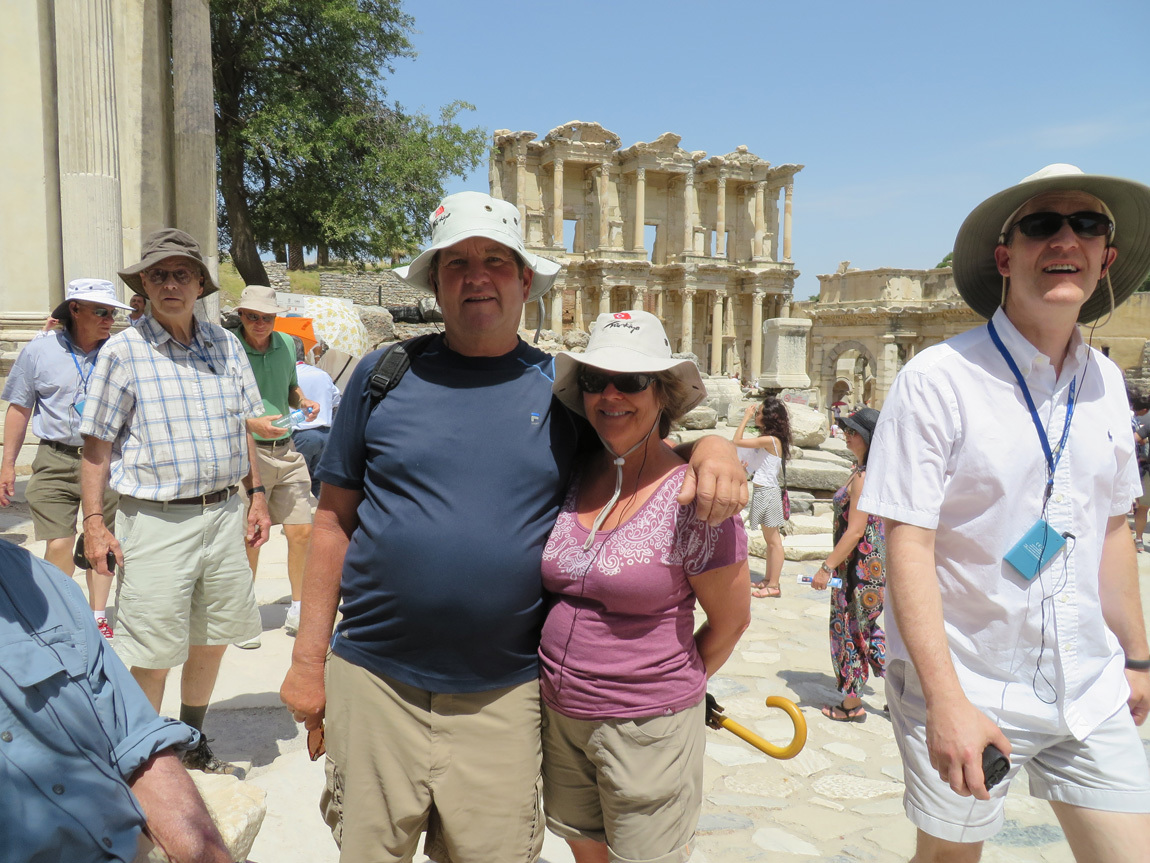
Now we are getting to the tall structure that has been grabbing our attention all the time we walked down Curetes Street. It is the gigantic Celsus Library:
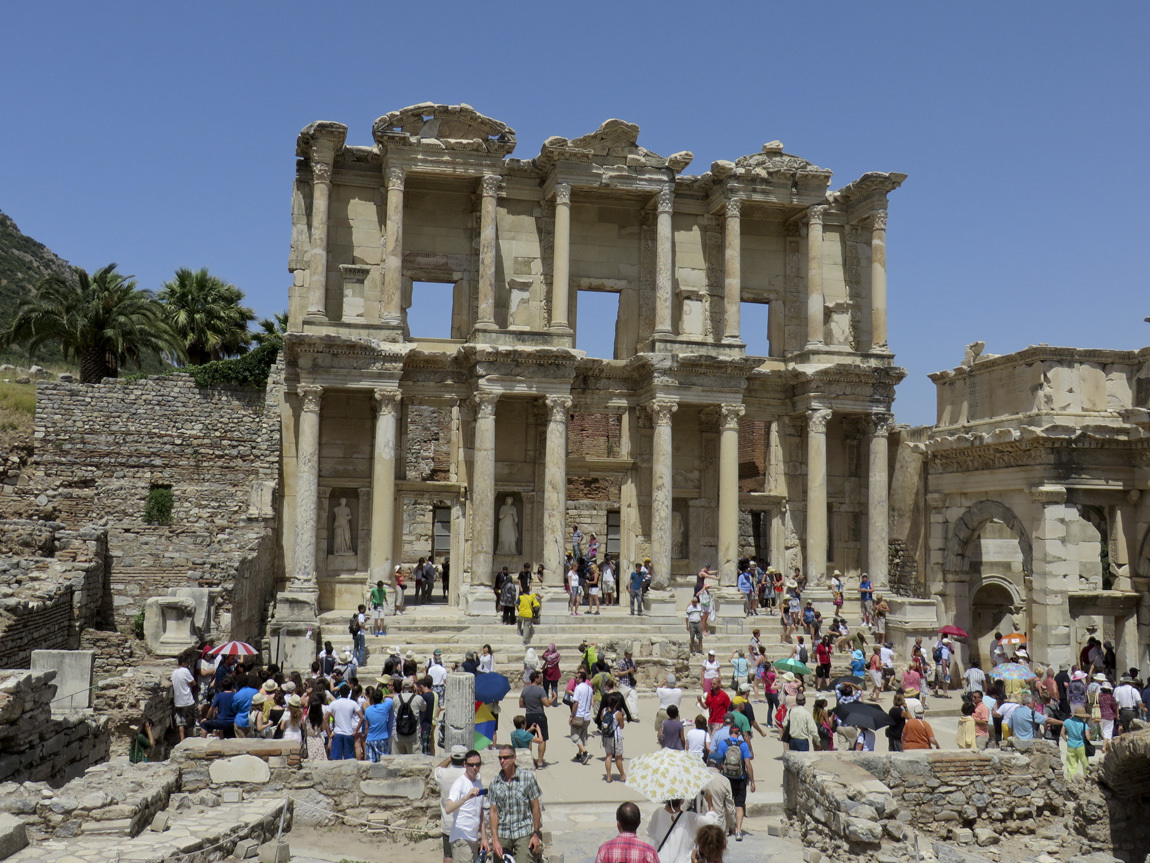
Celsus was the third richest library in ancient times after the Alexandra and Pergamum. The facade has two-stories, with Corinthian style columns, niches containing stature, and three entrances to the ground floor. The front facade (shown in the above photo) was rebuilt during the 1960s and 70s and is considered to be very true to the historic building, and now serves as a prime example of Roman public architecture.
This statue of Arete is the original statue; a rare site at Ephesus because most were moved to various museums. Arete is the goddess of valor.
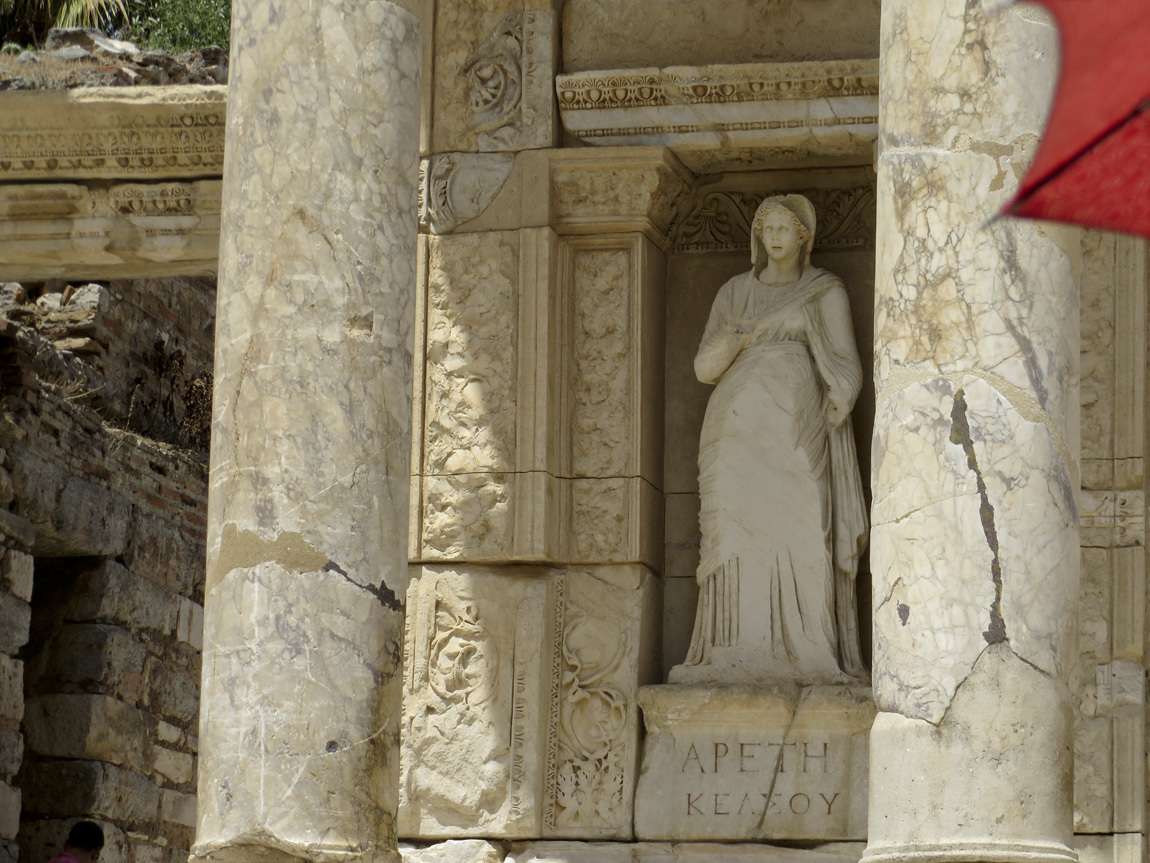
We went through one of the doors in the facade into the interior room. This room has not yet been fully restored. Inside is a central apse, where once a statue of Celsus or Athena (goddess of wisdom) stood. Celsus’ tomb lay directly below in a vaulted chamber. John stood for a photo:
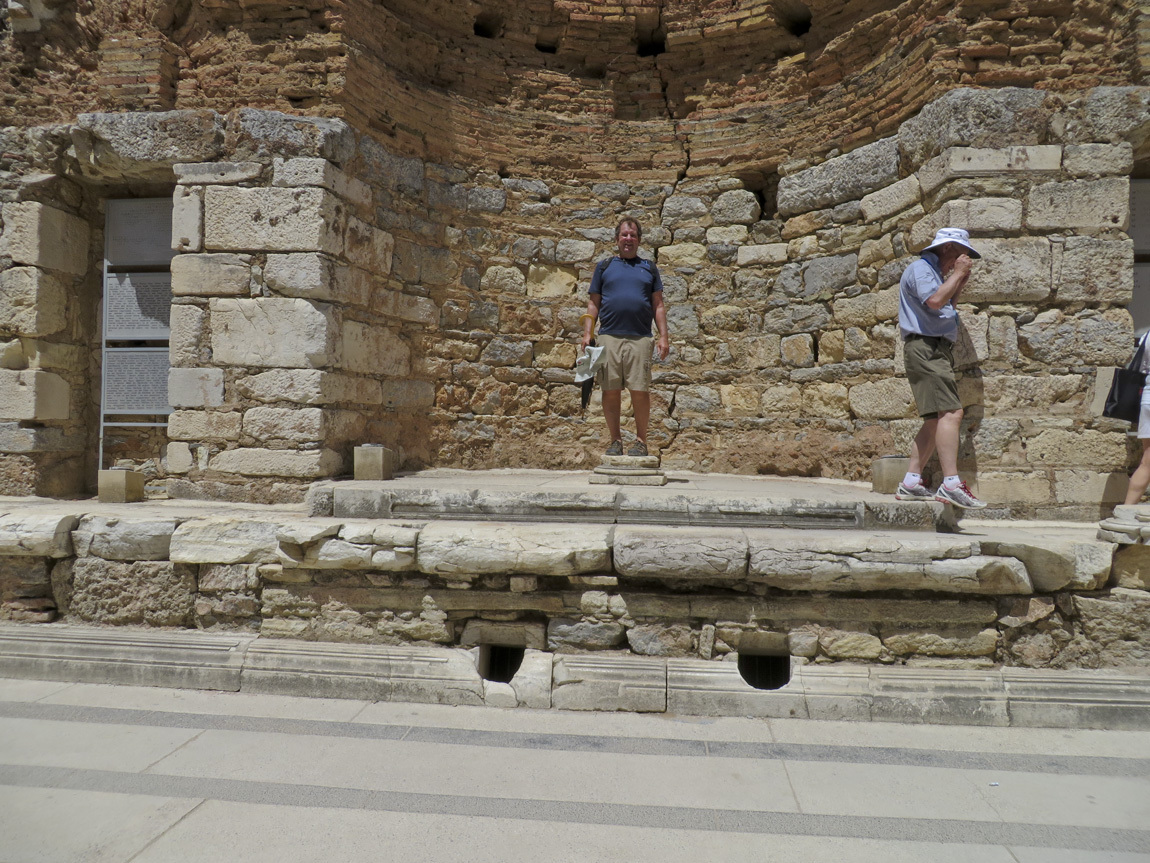
Along the other three sides of this room were rectangular recesses that held cupboards and niches for 12,000 scrolls. You can see one of the recesses on John's right in the above photo. There were double walls behind the bookcases to prevent them from heat, cold, and humidity.
The interior of the library and all its books were destroyed by fire in the devastating earthquake that struck the city in 262. Only the facade survived that quake, but it did not survive a later one that completely destroyed it.
Adjacent to the facade are the Gates of Mazeus and Mythridates:
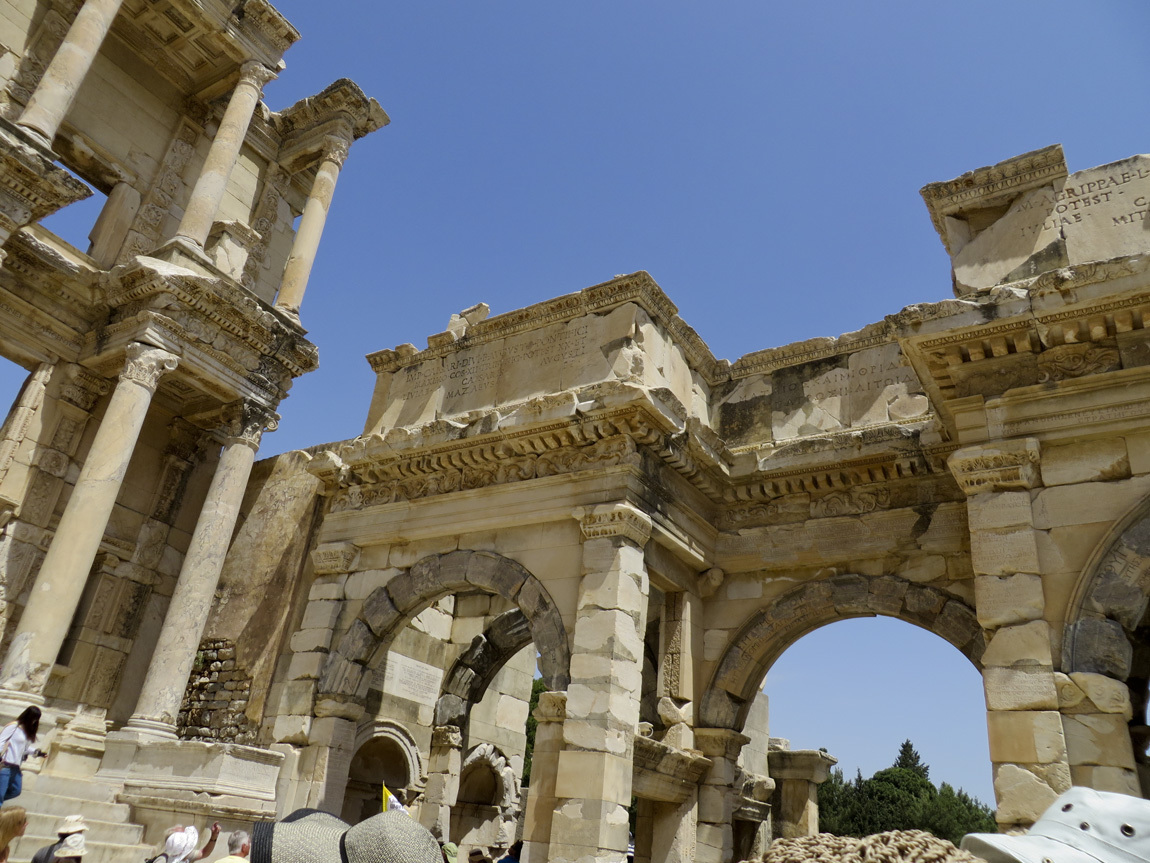
Next to the library is the Agora, a huge market place and trade center. It dates from the third century AD.
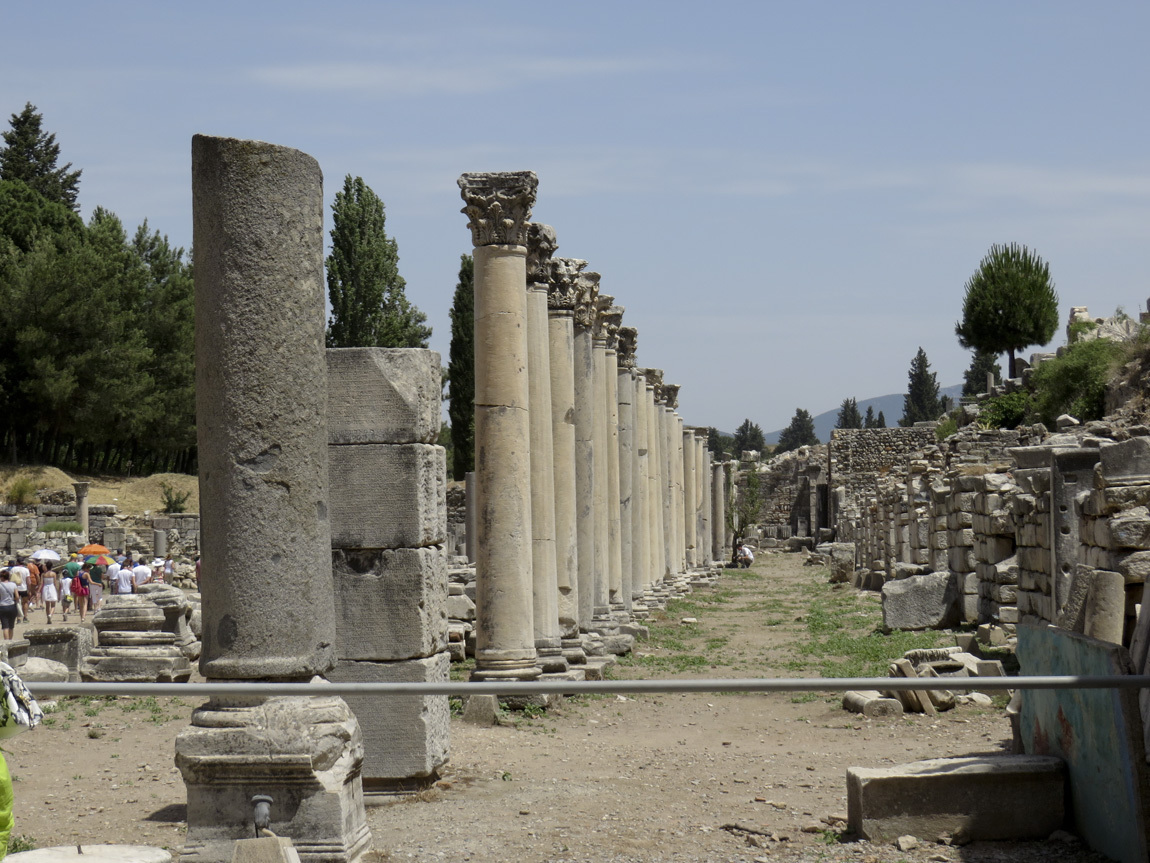
We only visited the main site of Ephesus. In the surrounding area are other ruins to visit, some important to the Christian faith, as Ephesus was an important center for the early Christians beginning in 50 AD. For instance, there is the Basilica of St. John and the House of Virgin Mary. From AD 52-54, Paul lived in Ephesus, working with the congregation and organizing missionary activities. Ephesus was one of the seven churches of Asia cited in the Book of Revelation. The Gospel of John may have been written in Ephesus.
The Great Theater was constructed in the Hellenistic period, in the 3rd century BC. During the Roman period, it was enlarged to its current size of 25,000 seats. This theater reaches three stories tall and is the largest in Anatolia (the area of Turkey).
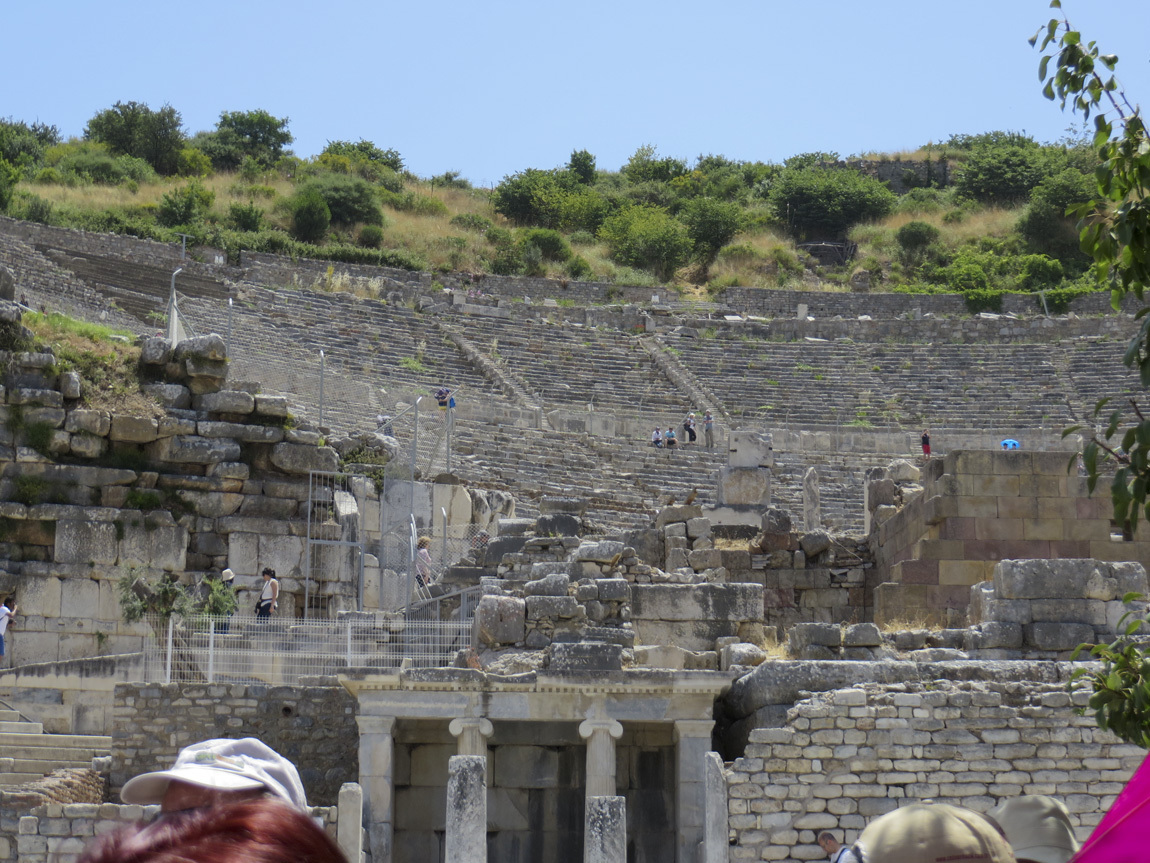
It's noon and the sun beats down on us as we walk to the Marble Road. I wish we could have spent a whole day here, a day with no one else around, a day not as hot as this one was, perhaps a day in the winter. A long day with a good museum book or a personal guide would have been perfect. I would have liked to sit and relax and have a picnic in the ruins of the library, walk in Hadrian's Temple, wander through the stones and crumbling structures, and discover more. Just think, two thousand years ago, intelligent, cultured humans lived here and built incredible structures. And a strong empire. Their buildings lasted for hundreds of years, until earthquakes brought them down. We know about their lives because they wrote of their history on papyrus scrolls. The scrolls in the Celsus Library were burned, but other scrolls survived to tell the stories. What will people two thousand years from now know about our culture? What "scrolls" and ruins will survive? What will mankind be like in two thousand years?
Such are my thoughts as we walk down the Marble Road and exit Ephesus.
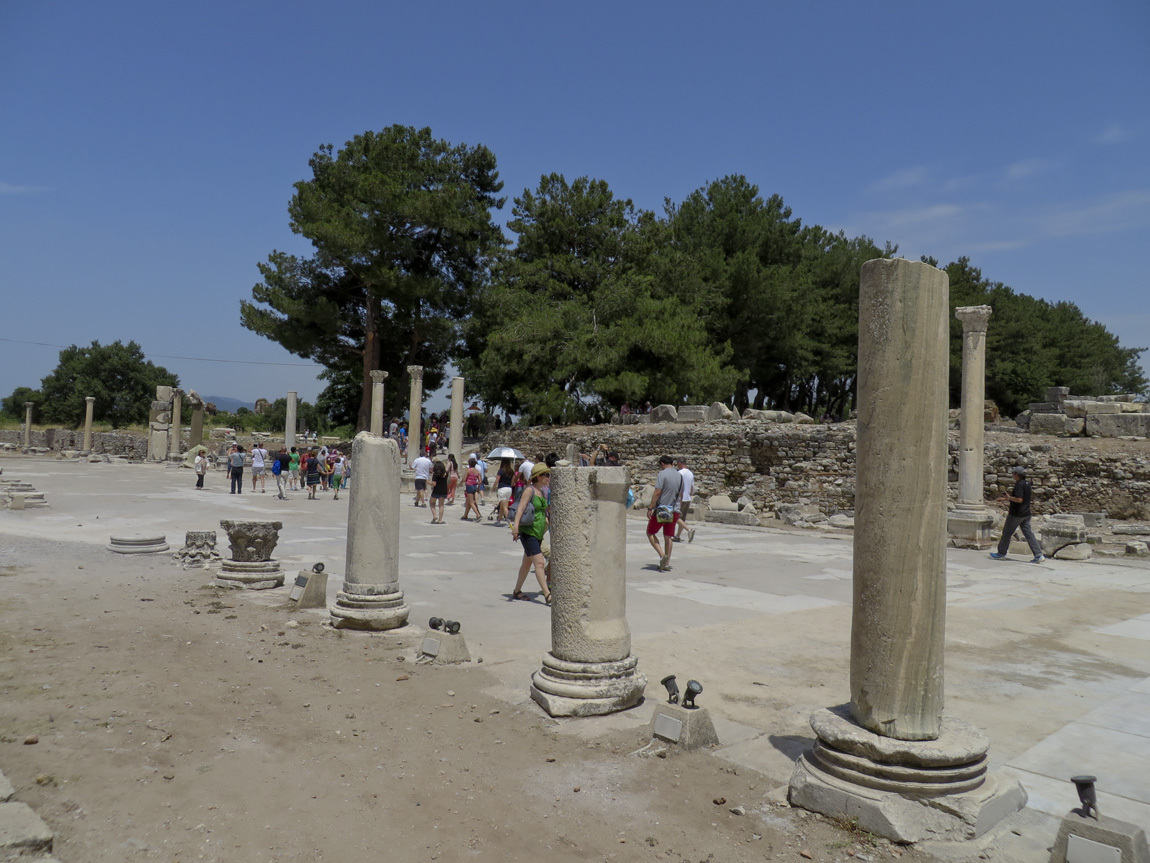
Navigation:
first Turkey post
next Turkey post
The ancient city is south of our hotel in Izmir, on the western coast of Turkey, near the town of Selcuk. We left our hotel early so as to arrive when it opened at 10 am - Ali knew it was best to see Ephesus as early as possible, before it got hot. (It was still hot.)
Like all of Turkey, Ephesus was conquered and lost by different ruling groups over the centuries; the following paragraph is my own abbreviated timeline.
Ephesus was founded by Ionian Greeks in the 10th century BC. Later it was controlled sequentially by the Cimmerians, various tyrants, the Lydians, the Persians, the Ionians (again), and in the 5th century BC, the Persians (again). Then, in 334 BC, Alexander the Great liberated Ephesus. By the 1st century BC, Ephesus was under firm Roman control. After Augustus became emperor in 27 BC, Ephesus entered a period of prosperity and grew to a population of 250,000, making it one of the largest cities in the Mediterranean area. The city was damaged by the Goths in 263 AD. Constantine I, who reigned from 306-337 AD, rebuilt the city. From 395-1308 AD, Ephesus was part of the Byzantine Empire (Greek-speaking Roman Empire). The Turks of the Ottoman Empire controlled the city from the fourteenth century until the establishment of modern Turkey in the twentieth century.
We enter the site in a bustle of tourists and pass water closets and souvenir stands. John and I bought Turkey hats to protect our heads. Then we follow the path into Ephesus. Another tour group gathers under a shady tree; all we see at first are more stone-sized ruins. Not too impressive.

Then we do come to an impressive structure: the Bath of Varius, dating from the second century.

A pile of pipes used to carry hot air to heat the buildings:

Next to the Bath of Varius is the Basilica. It was used for commercial business and courts of law. Statues of Augustus and his wife used to be in the Basilica, but they are now in the Ephesus Museum (in Selcuk, Turkey). The Basilica was destroyed in an earthquake in the fourth century. I liked the figures of the bulls on top of the big stones.


The Odeon, below, is a small theater constructed in the second century. It was used for meetings of the senate and also as a concert hall for performances. Its capacity was 1500 people; it used to be enclosed with a roof.

Aren't all the people taking pictures fun?
An archway after the Odeon:

Another Turkey cat:

Temenos: remains of two temples erected in the first century in honor of Julius Caesar and Rome.

Next we come to ruins of the Prytaneion, probably built in the Augustan period (27 BC - 14 AD). The Prytaneion served as the office of the city's leading government dignitary. Tall columned porches (called peristyles) formed a courtyard. The main room of the Prytaneion was used for public banquets, and the stone blocks in the center served as either an altar or a place for food preparation. At one time two statues of Artemis were in the courtyard (now in the Ephesus Museum). (This information was on a sign at the site.)

Not sure what this is, but I like it:

The Domitian Temple was built in honor of the emperor Domitian (81-96 AD).

The relief of the flying Nike:

Memmius Monument:

Curetes Street runs between the Hercules Gate (sorry, no photo) and the Celsus Library (photos further down). The photo directly below shows how very crowded it was the day we visited; the next photo was a wee bit later and you can see the street better:


Those columns in the distance are huge! Nothing we saw at Troy, Pergamum, or the Asclepieum were close to the size. No wonder this place is so crowded.
We start walking down Curetes Street. There used to be fountains, monuments, statues and shops on the sides of the street. But many earthquakes hit Ephesus, and most structures - especially columns - were damaged. Some columns were replaced by columns from elsewhere in the city; hence, they show different designs.
Partial statue and columns along Curetes Street:

The Fountain of Trajan was built around 104 AD. Built for Emperor Trajan, his statue used to stand in the center, overlooking a pool. The pool was 20x10 meters and surrounded by columns and statues. The statues are now in the Ephesus Museum (in Turkey).

Next along Curetes Street is the Temple of Hadrian. Hadrian was one of the "Five of Good Emperors" of the Roman Empire. During his reign (117-138 AD), there were not a lot of military actions; he ruled through strength rather than campaign. Hadrian was a patron of the arts, and he admired Greek culture. He visited Ephesus in 128 AD, and the Temple of Hadrian was built soon thereafter. It's amazing to realize that the Roman empire once reached all the way from past Turkey to Great Britain (known as Roman Britain at the time), as marked by Hadrian's Wall. One can only imagine how difficult it was to rule such a large empire back when transportation and communication were so slow.
The facade of the Temple of Hadrian has four Corinthian columns supporting a curved arch. The side columns are square. We try to imagine what it used to look like. Then Ali pulled out this neat museum book that showed how each ruined structure looks now, and then had an overlay page that showed how it looked in its prime. That was cool.

In the middle of the arch is a relief of Tyche, the goddess of victory.

Inside the temple is a human figure, probably Medusa:

On both sides of the Medusa there are friezes depicting the story of the foundation of Ephesus. This photo shows the left side - Androklos shooting a boar, Dionysus in ceremonial procession and the Amazons. These friezes in the photos are only copies; the originals are displayed in Ephesus Museum.

Can you guess what these are?

If you said "latrines" or something like that then you are right. The toilets are aligned along the walls, and there used to be a pool in the middle of the building. I seem to remember Ali saying these toilets were only for the elite, but this web site says they were the public toilets and there was an entrance fee to use them. Built in the first century, a canal system brought in water was in and there was a drainage system under the toilets. Hot air forced through these large clay pipes heated the walls.

We've been at Ephesus about an hour. Here is a look down hot and crowded Curetes Street:

We don't go back down Curetes Street quite yet. Ali has arranged for us to visit a special exhibit, the Terrace Houses, on the hill opposite Hadrian's Temple. This is a museum and an active restoration at the same time. The entire area is covered with a roof supported by scaffolding - a nice break from the unrelenting sun.
The Terrace Houses are where the elite of Ephesus lived. Built in the early Roman Imperial period (ca 20 AD), the units are multi-storeyed with tall, open interior courtyards framed by columned porches ("peristyle"). Living and work spaces were arranged around the courtyards. Rooms were heated by hot air carried by clay pipes beneath the floors and behind the walls. Hot and cold water was supplied and drained through a system of wells and canals. There were toilets and kitchens. Civilization!
The Terrace Houses were once richly decorated with mosaics and frescos. At the time of our visit, two of the houses had been partially restored by consolidating mosaics and frescoes from all of the original dwellings. The photo below shows a peristyle courtyard, the restoration supports, and tables full of pieces of walls, floors, frescos and art that are being fitted back together, like a big puzzle:

This spacious and high room is called the "Marble Hall". According to a sign at the museum, "around 100 AD it received marble furnishings on the walls and floors, a niche fountain at the back wall and a central basin. The banqueting hall provided a luxurious setting for both private and official occasions, and presented the social status and prosperity of the landlord plainly to every guest."

An example of a marble wall decoration being pieced back together:

Not sure what this led to:

Wall art:

This museum worker doesn’t seem too happy to see us:

Looking down:

Wall art:

Restoration in progress:

A lion mosaic on the floor:

A corner that shows wall art as well as water and heater pipes:

Courtyard, partially restored:

A series of earthquakes in the 3rd century AD put a sudden end to the dwellings in the city center of Ephesos. An extensive reorganization of the area took place in the early 7th century, when an early Byzantine handicraft quarter with mills, smithies and potteries was established over the Roman residential building. (Information from the signs in the museum.)
View from the hillside, where we exited the Terrace Houses:

Here we are, in our Turkey floppy hats:

Now we are getting to the tall structure that has been grabbing our attention all the time we walked down Curetes Street. It is the gigantic Celsus Library:

Celsus was the third richest library in ancient times after the Alexandra and Pergamum. The facade has two-stories, with Corinthian style columns, niches containing stature, and three entrances to the ground floor. The front facade (shown in the above photo) was rebuilt during the 1960s and 70s and is considered to be very true to the historic building, and now serves as a prime example of Roman public architecture.
This statue of Arete is the original statue; a rare site at Ephesus because most were moved to various museums. Arete is the goddess of valor.

We went through one of the doors in the facade into the interior room. This room has not yet been fully restored. Inside is a central apse, where once a statue of Celsus or Athena (goddess of wisdom) stood. Celsus’ tomb lay directly below in a vaulted chamber. John stood for a photo:

Along the other three sides of this room were rectangular recesses that held cupboards and niches for 12,000 scrolls. You can see one of the recesses on John's right in the above photo. There were double walls behind the bookcases to prevent them from heat, cold, and humidity.
The interior of the library and all its books were destroyed by fire in the devastating earthquake that struck the city in 262. Only the facade survived that quake, but it did not survive a later one that completely destroyed it.
Adjacent to the facade are the Gates of Mazeus and Mythridates:

Next to the library is the Agora, a huge market place and trade center. It dates from the third century AD.

We only visited the main site of Ephesus. In the surrounding area are other ruins to visit, some important to the Christian faith, as Ephesus was an important center for the early Christians beginning in 50 AD. For instance, there is the Basilica of St. John and the House of Virgin Mary. From AD 52-54, Paul lived in Ephesus, working with the congregation and organizing missionary activities. Ephesus was one of the seven churches of Asia cited in the Book of Revelation. The Gospel of John may have been written in Ephesus.
The Great Theater was constructed in the Hellenistic period, in the 3rd century BC. During the Roman period, it was enlarged to its current size of 25,000 seats. This theater reaches three stories tall and is the largest in Anatolia (the area of Turkey).

It's noon and the sun beats down on us as we walk to the Marble Road. I wish we could have spent a whole day here, a day with no one else around, a day not as hot as this one was, perhaps a day in the winter. A long day with a good museum book or a personal guide would have been perfect. I would have liked to sit and relax and have a picnic in the ruins of the library, walk in Hadrian's Temple, wander through the stones and crumbling structures, and discover more. Just think, two thousand years ago, intelligent, cultured humans lived here and built incredible structures. And a strong empire. Their buildings lasted for hundreds of years, until earthquakes brought them down. We know about their lives because they wrote of their history on papyrus scrolls. The scrolls in the Celsus Library were burned, but other scrolls survived to tell the stories. What will people two thousand years from now know about our culture? What "scrolls" and ruins will survive? What will mankind be like in two thousand years?
Such are my thoughts as we walk down the Marble Road and exit Ephesus.

Navigation:
first Turkey post
next Turkey post
Comments
No comments yet
Add Comment